Paul van Yperen's Blog, page 359
January 2, 2016
Charles de Rochefort
Charles de Rochefort (1887-1952) was a star of the French silent cinema. He appeared in 34 films between 1911 and 1932, sometimes as a French cowboy. In 1923 he went to the US and made several films in Hollywood. After his return to France, he became a director of sound films.
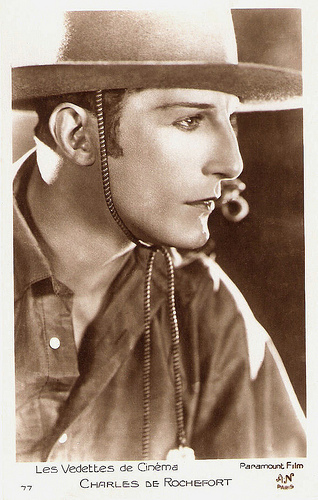
French postcard by A.N., Paris, in the series Les Vedettes de Cinéma, no. 77. Photo: Paramount Film.
Serials
Charles d’Authier de Rochefort was born in Port-Vendres, France, in 1887. He was the son of Paul Charles Dominique d'Authier de Rochefort and Camille Caroline Rose Félicité Guelfucci.
In 1905 he started to work in the theatre and the music-halls. In 1910 he made his film debut. One of his first films was the short Pathé comedy Max se marie/Max's Divorce (Max Linder, Lucien Nonguet, 1911) with Max Linder . He would play in eight Linder films between 1910 and 1914.
He also appeared in Pathé dramas by Georges Denola, Albert Capellani and Abel Gance . In 1918 he performed in the serial Impéria (12 episodes) by Jacques Durand, with Jacqueline Forzane.
Then followed the films Marthe (Gaston Roudès, 1919), Fille du peuple/Girl of the People (Camille de Morlhon, 1920), L’empire du diamant/The Empire of the Diamond (Léonce Perret, 1920) and Roi de Camargue/King of Camargue (André Hugon, 1921).
De Rochefort again appeared in two serial films: Gigolette (Henri Pouctal, 1921, 4 episodes) and L’empereur des pauvres (René Leprince, 1921, 6 episodes) with Gina Manés and a young Lily Damita .
In 1922, De Rochefort played in several films: in André Antoine’s L’Arlésienne/The Girl from Arles, two films by André Hugon: Notre dame d’amour/Our Lady of Love and Le diamant noir/The Black Diamond, L’homme qui pleure/The Crying man by Louis d’Hée and Louis de Verande, and the British-French co-production The Spanish Jade/Sous le soleil d’Espagne by John S. Robertson and starring Evelyn Brent.
After two more French films, La dame au ruban de velours (Giuseppe Guarino, 1923) with Arlette Marchal , and La faute des autres/Other's Fault (Jacques Olivier, 1923), Charles de Rochefort left France and went again to the United States.
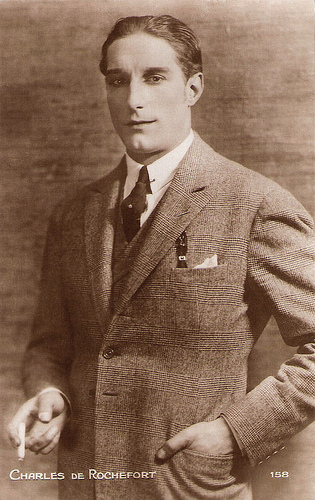
French postcard by Cinémagazine-Edition, no. 158.
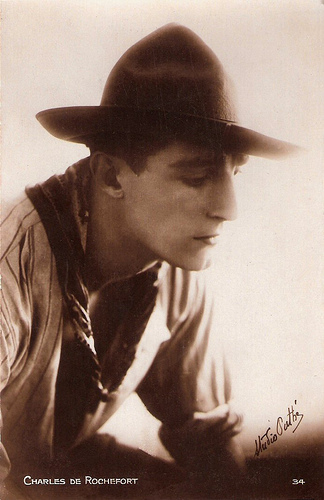
French postcard by Editions Cinémagazine, no. 34. Photo: Studio Pathé.
Super-production
In Hollywood, Charles de Rochefort played in The Marriage Maker (William C. DeMille, 1923) with Mary Astor.
He briefly appeared in Hollywood/Joligud (James Cruze, 1923) and with Dorothy Dalton in The Law of the Lawless (Victor Fleming, 1923). Credited as Charles De Roche, he also played opposite Pola Negri in The Cheat (George Fitzmaurice, 1923), a remake of Cecil B. DeMille's 1915 hit feature using the same script by Hector Turnbull and Jeanie MacPherson.
His best known Hollywood part was Pharaoh Rameses, the Magnificent in the prologue of the epic The Ten Commandments (Cecil B. DeMille, 1923) with Rod La Rocque.
In the following year De Rochefort appeared in four more American films: Love and Glory (Rupert Julian, 1924), Shadows of Paris (Herbert Brenon, 1924), The White Moth (Maurice Tourneur, 1924) starring Barbara LaMarr; and Madame Sans-Gêne (Léonce Perret, 1924), a super-production around Gloria Swanson .
In 1925 Rochefort left Hollywood and returned to France, where he played in La princesse aux clowns/The Princess and the Clowns (André Hugon, 1925) with Huguette Duflos .
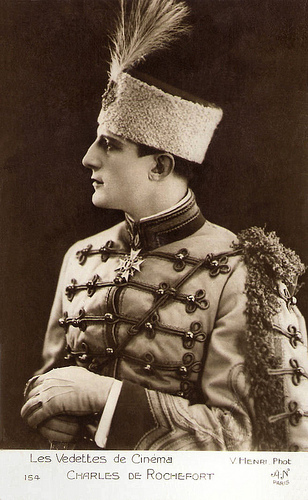
French postcard by A.N., Paris, no. 154. Photo: V. Henri.
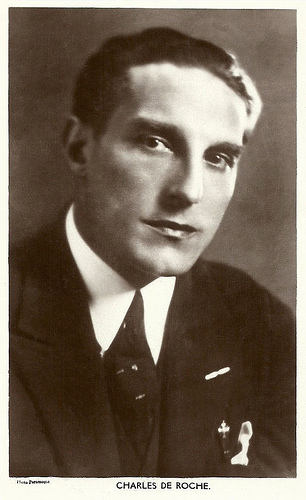
British postcard in the Picturegoer Series, London, no. 141. Photo: Paramount.
Multilingual Productions
Charles de Rochefort then stayed away from the cinema for four years. When he returned in 1929 it was not as actor but as director.
Meanwhile sound film had arrived. At the Paramount Pictures studio at Joinville-le-Pont in Paris, he directed the sound film Une femme a menti/A Woman Has Lied (1929) with Louise Lagrange and scripted by immigrant Hermann Kosterlitz (aka Henry Koster).
In 1930 he made the French, Italian, Czech and Rumanian version of Paramount on Parade, starring resp. Maurice Chevalier , Carmen Boni , Jiri Voskovec and Pola Illéry .
Rochefort also directed the multilingual Le secret du docteur/The Secret of the Doctor (1930), with Marcelle Chantal in the French and Eugenia Zoffoli in the Spanish version.
In 1931 Rochefort acted once more in the film La croix du sud/Southern Cross (André Hugon, 1931), for which he also did the photography, and he directed Televisione (1931), the Italian version of the Paramount multilingual Magie moderne/Television. He also directed the short Dorville chauffeur (1930) and Un bouquet de flirts (1931) with Josette Day.
He went on to work on stage and had his own theatre in Paris, the Theatre Charles de Rochefort, which still exists today as the Théâtre Tristan-Bernard at 64 rue Rocher. In 1943 he wrote the book Le Film de Mes Souvenirs (Secrets de Vedettes).
Charles de Rochefort died in Paris in 1952. He was 64.
First Part of The Ten Commandments (1923). Source: joe25Xcel (YouTube).
Sources: Pascal Donald (CineArtistes - French), Wikipedia and .

French postcard by A.N., Paris, in the series Les Vedettes de Cinéma, no. 77. Photo: Paramount Film.
Serials
Charles d’Authier de Rochefort was born in Port-Vendres, France, in 1887. He was the son of Paul Charles Dominique d'Authier de Rochefort and Camille Caroline Rose Félicité Guelfucci.
In 1905 he started to work in the theatre and the music-halls. In 1910 he made his film debut. One of his first films was the short Pathé comedy Max se marie/Max's Divorce (Max Linder, Lucien Nonguet, 1911) with Max Linder . He would play in eight Linder films between 1910 and 1914.
He also appeared in Pathé dramas by Georges Denola, Albert Capellani and Abel Gance . In 1918 he performed in the serial Impéria (12 episodes) by Jacques Durand, with Jacqueline Forzane.
Then followed the films Marthe (Gaston Roudès, 1919), Fille du peuple/Girl of the People (Camille de Morlhon, 1920), L’empire du diamant/The Empire of the Diamond (Léonce Perret, 1920) and Roi de Camargue/King of Camargue (André Hugon, 1921).
De Rochefort again appeared in two serial films: Gigolette (Henri Pouctal, 1921, 4 episodes) and L’empereur des pauvres (René Leprince, 1921, 6 episodes) with Gina Manés and a young Lily Damita .
In 1922, De Rochefort played in several films: in André Antoine’s L’Arlésienne/The Girl from Arles, two films by André Hugon: Notre dame d’amour/Our Lady of Love and Le diamant noir/The Black Diamond, L’homme qui pleure/The Crying man by Louis d’Hée and Louis de Verande, and the British-French co-production The Spanish Jade/Sous le soleil d’Espagne by John S. Robertson and starring Evelyn Brent.
After two more French films, La dame au ruban de velours (Giuseppe Guarino, 1923) with Arlette Marchal , and La faute des autres/Other's Fault (Jacques Olivier, 1923), Charles de Rochefort left France and went again to the United States.

French postcard by Cinémagazine-Edition, no. 158.

French postcard by Editions Cinémagazine, no. 34. Photo: Studio Pathé.
Super-production
In Hollywood, Charles de Rochefort played in The Marriage Maker (William C. DeMille, 1923) with Mary Astor.
He briefly appeared in Hollywood/Joligud (James Cruze, 1923) and with Dorothy Dalton in The Law of the Lawless (Victor Fleming, 1923). Credited as Charles De Roche, he also played opposite Pola Negri in The Cheat (George Fitzmaurice, 1923), a remake of Cecil B. DeMille's 1915 hit feature using the same script by Hector Turnbull and Jeanie MacPherson.
His best known Hollywood part was Pharaoh Rameses, the Magnificent in the prologue of the epic The Ten Commandments (Cecil B. DeMille, 1923) with Rod La Rocque.
In the following year De Rochefort appeared in four more American films: Love and Glory (Rupert Julian, 1924), Shadows of Paris (Herbert Brenon, 1924), The White Moth (Maurice Tourneur, 1924) starring Barbara LaMarr; and Madame Sans-Gêne (Léonce Perret, 1924), a super-production around Gloria Swanson .
In 1925 Rochefort left Hollywood and returned to France, where he played in La princesse aux clowns/The Princess and the Clowns (André Hugon, 1925) with Huguette Duflos .

French postcard by A.N., Paris, no. 154. Photo: V. Henri.

British postcard in the Picturegoer Series, London, no. 141. Photo: Paramount.
Multilingual Productions
Charles de Rochefort then stayed away from the cinema for four years. When he returned in 1929 it was not as actor but as director.
Meanwhile sound film had arrived. At the Paramount Pictures studio at Joinville-le-Pont in Paris, he directed the sound film Une femme a menti/A Woman Has Lied (1929) with Louise Lagrange and scripted by immigrant Hermann Kosterlitz (aka Henry Koster).
In 1930 he made the French, Italian, Czech and Rumanian version of Paramount on Parade, starring resp. Maurice Chevalier , Carmen Boni , Jiri Voskovec and Pola Illéry .
Rochefort also directed the multilingual Le secret du docteur/The Secret of the Doctor (1930), with Marcelle Chantal in the French and Eugenia Zoffoli in the Spanish version.
In 1931 Rochefort acted once more in the film La croix du sud/Southern Cross (André Hugon, 1931), for which he also did the photography, and he directed Televisione (1931), the Italian version of the Paramount multilingual Magie moderne/Television. He also directed the short Dorville chauffeur (1930) and Un bouquet de flirts (1931) with Josette Day.
He went on to work on stage and had his own theatre in Paris, the Theatre Charles de Rochefort, which still exists today as the Théâtre Tristan-Bernard at 64 rue Rocher. In 1943 he wrote the book Le Film de Mes Souvenirs (Secrets de Vedettes).
Charles de Rochefort died in Paris in 1952. He was 64.
First Part of The Ten Commandments (1923). Source: joe25Xcel (YouTube).
Sources: Pascal Donald (CineArtistes - French), Wikipedia and .
Published on January 02, 2016 22:00
January 1, 2016
Henry Edwards
Tall, British actor Henry Edwards (1882-1952) was a famous star of the Hepworth studio in the silent period. He was also active as an innovative film producer and director. Between 1914 and 1952 he appeared in 81 films and directed 67 films.
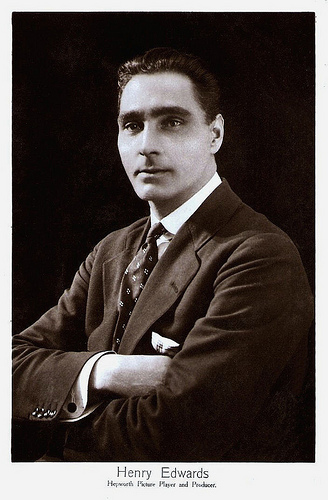
British postcard. Photo: Hepworth.
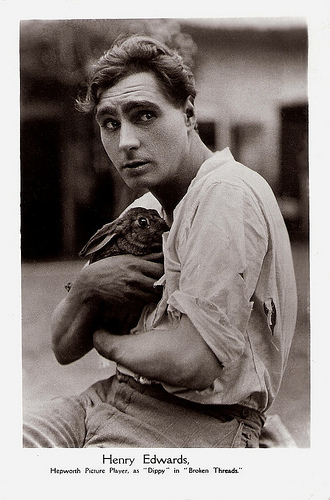
British postcard. Photo: Hepworth. Publicity still for Broken Threads (Henry Edwards, 1917) with Edwards as Dippy.
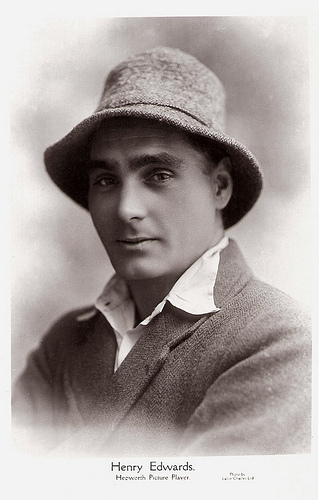
British postcard. Photo: Lallie Charles / Hepworth.
Britain's answer to Douglas Fairbanks and Mary Pickford
Henry Edwards was born Arthur Harold Ethelbert Edwards in Weston-Super-Mare, England. Lured to the stage, he trod the boards for fifteen years as an actor, producer, and playwright. He began in 1900 in provincial theatres, graduated to London's West End in 1911, and in 1913 played opposite Ethel Barrymore in New York.
He made his first film appearance in 1914 with a small role in Clancarty (Harold M. Shaw, 1914). Under the guidance of producer/director Cecil Hepworth, Edwards became one of England's most popular leading men. The tall, tousled, sensitive actor repeated his stage role in the spy drama The Man Who Stayed at Home (Cecil M. Hepworth, 1915).
The Americans Larry Trimble and Florence Turner, based at Hepworth's Walton studios, quickly hired his services, initially as an actor and writer; his directing debut came with A Welsh Singer (Henry Edwards, 1915), adapted from a popular romantic novel. After East is East (Henry Edwards, 1916), Turner and Trimble returned to the States; Edwards then formally joined the Walton studio, generating much of its product along with Hepworth at a time when war service had thinned the company's ranks.
His most frequent leading lady was the blonde and lissom Chrissie White , whom he married in 1922. Celebrated as Britain's answer to Douglas Fairbanks and Mary Pickford, Edwards and White co-starred in 22 Hepworth dramas, playing everything from aristocrats to the ‘working poor’ with consummate artistry; unfortunately, only two of their features survive.
The series of films with Edwards and White flourished until financial woes brought down Hepworth's enterprise in 1924. Edwards proved himself as the noble and self-sacrificing hero in the stout-hearted adventure The Flag Lieutenant (Maurice Elvey, 1926), which was well-received.
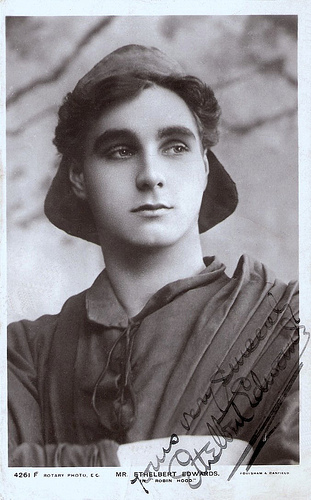
British postcard by Rotary Photo, no. 4261 F. Sent by mail in 1907. Photo: Foulsham & Banfield. Publicity still for Robin Hood.
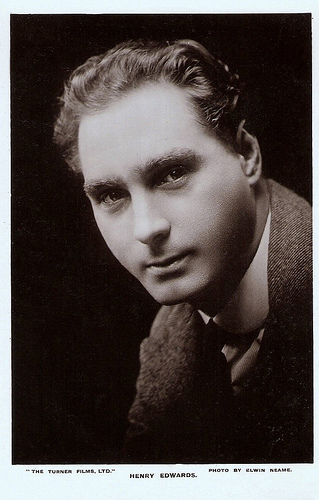
British postcard for The Turner Films Ltd. Photo: Elwin Neame.
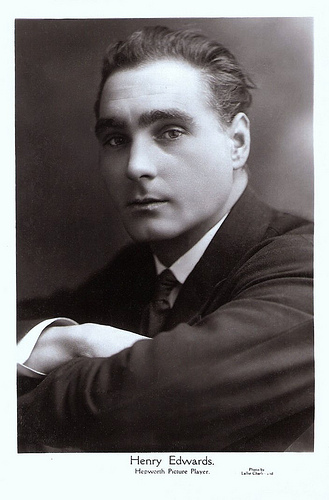
British postcard for Hepworth. Photo: Lallie Charles.
Subtleties of Characterisation, Feeling, and Visual Design
During his stay with Hepworth, Henry Edwards was given the opportunity to direct. Geoff Brown and Bryony Dixon write in the Reference Guide to British and Irish Film Directors: "From the beginning, he explored new territory in British cinema, particularly in films based on his own original scenarios."
In the 1910s and 1920s, he helped to advance British cinema beyond its early concentration on physical action towards the subtleties of characterisation, feeling, and visual design required for the mature feature film. In 1923 Edwards' experiments with cinema narrative led him to mount an entire feature without using inter-titles. The result, Lily of the Alley, now seemingly a lost film, broke new ground in Britain, though contemporary comment suggests a brave attempt rather than a stylistic triumph.
After 1925 Edwards was best known for his directorial efforts like the Boris Karloff melodrama Juggernaut (1935) and the Sir Seymour Hicks version of Scrooge (1935). At the Venice Film Festival of 1936 he won a Special Recommendation for Scrooge.
Henry Edwards returned to acting in 1946, essaying small character roles in films like Green for Danger (Sidney Gilliat, 1946), Oliver Twist (David Lean, 1948) and the all-star The Magic Box (John Boulting, 1952). His last appearance was in The Long Memory (1952, Robert Hamer).
He died suddenly from a heart attack at his home in Chobham, Surrey, in 1952. Chrissie White lived in retirement until 1987. Their daughter, Henryetta Edwards, appeared in several films in the 1950s. Henry Edwards’ career papers have recently been donated to the BFI Special Collections.
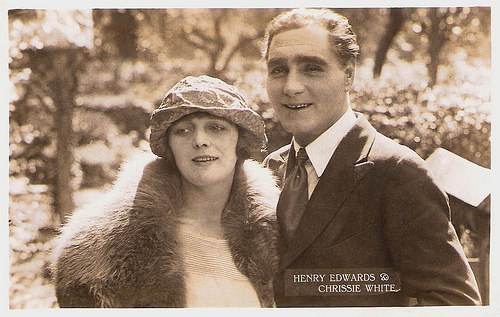
British postcard by TIC. With Chrissie White .
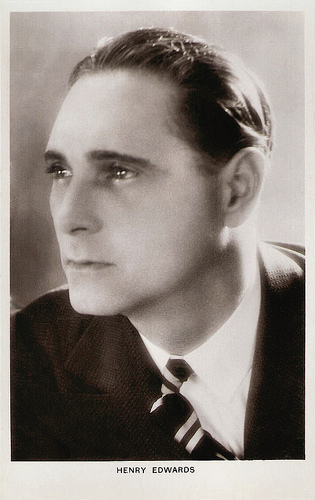
British postcard in the Picturegoer Series, London, no. 448.
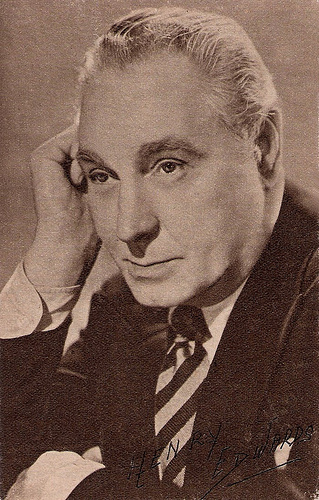
Dutch postcard, 1948.
Sources: Geoff Brown and Bryony Dixon (Reference Guide to British and Irish Film Directors), Hal Erickson (AllMovie), Wikipedia and .

British postcard. Photo: Hepworth.

British postcard. Photo: Hepworth. Publicity still for Broken Threads (Henry Edwards, 1917) with Edwards as Dippy.

British postcard. Photo: Lallie Charles / Hepworth.
Britain's answer to Douglas Fairbanks and Mary Pickford
Henry Edwards was born Arthur Harold Ethelbert Edwards in Weston-Super-Mare, England. Lured to the stage, he trod the boards for fifteen years as an actor, producer, and playwright. He began in 1900 in provincial theatres, graduated to London's West End in 1911, and in 1913 played opposite Ethel Barrymore in New York.
He made his first film appearance in 1914 with a small role in Clancarty (Harold M. Shaw, 1914). Under the guidance of producer/director Cecil Hepworth, Edwards became one of England's most popular leading men. The tall, tousled, sensitive actor repeated his stage role in the spy drama The Man Who Stayed at Home (Cecil M. Hepworth, 1915).
The Americans Larry Trimble and Florence Turner, based at Hepworth's Walton studios, quickly hired his services, initially as an actor and writer; his directing debut came with A Welsh Singer (Henry Edwards, 1915), adapted from a popular romantic novel. After East is East (Henry Edwards, 1916), Turner and Trimble returned to the States; Edwards then formally joined the Walton studio, generating much of its product along with Hepworth at a time when war service had thinned the company's ranks.
His most frequent leading lady was the blonde and lissom Chrissie White , whom he married in 1922. Celebrated as Britain's answer to Douglas Fairbanks and Mary Pickford, Edwards and White co-starred in 22 Hepworth dramas, playing everything from aristocrats to the ‘working poor’ with consummate artistry; unfortunately, only two of their features survive.
The series of films with Edwards and White flourished until financial woes brought down Hepworth's enterprise in 1924. Edwards proved himself as the noble and self-sacrificing hero in the stout-hearted adventure The Flag Lieutenant (Maurice Elvey, 1926), which was well-received.

British postcard by Rotary Photo, no. 4261 F. Sent by mail in 1907. Photo: Foulsham & Banfield. Publicity still for Robin Hood.

British postcard for The Turner Films Ltd. Photo: Elwin Neame.

British postcard for Hepworth. Photo: Lallie Charles.
Subtleties of Characterisation, Feeling, and Visual Design
During his stay with Hepworth, Henry Edwards was given the opportunity to direct. Geoff Brown and Bryony Dixon write in the Reference Guide to British and Irish Film Directors: "From the beginning, he explored new territory in British cinema, particularly in films based on his own original scenarios."
In the 1910s and 1920s, he helped to advance British cinema beyond its early concentration on physical action towards the subtleties of characterisation, feeling, and visual design required for the mature feature film. In 1923 Edwards' experiments with cinema narrative led him to mount an entire feature without using inter-titles. The result, Lily of the Alley, now seemingly a lost film, broke new ground in Britain, though contemporary comment suggests a brave attempt rather than a stylistic triumph.
After 1925 Edwards was best known for his directorial efforts like the Boris Karloff melodrama Juggernaut (1935) and the Sir Seymour Hicks version of Scrooge (1935). At the Venice Film Festival of 1936 he won a Special Recommendation for Scrooge.
Henry Edwards returned to acting in 1946, essaying small character roles in films like Green for Danger (Sidney Gilliat, 1946), Oliver Twist (David Lean, 1948) and the all-star The Magic Box (John Boulting, 1952). His last appearance was in The Long Memory (1952, Robert Hamer).
He died suddenly from a heart attack at his home in Chobham, Surrey, in 1952. Chrissie White lived in retirement until 1987. Their daughter, Henryetta Edwards, appeared in several films in the 1950s. Henry Edwards’ career papers have recently been donated to the BFI Special Collections.

British postcard by TIC. With Chrissie White .

British postcard in the Picturegoer Series, London, no. 448.

Dutch postcard, 1948.
Sources: Geoff Brown and Bryony Dixon (Reference Guide to British and Irish Film Directors), Hal Erickson (AllMovie), Wikipedia and .
Published on January 01, 2016 22:00
December 31, 2015
EFSP's Dazzling Dozen: New Rares from the Collection of Didier Hanson
Happy New Year! We wish you all the best for 2016. And how can EFSP better start a new year of posts than with twelve new and rare acquisitions from the collection of our friend Didier Hanson...
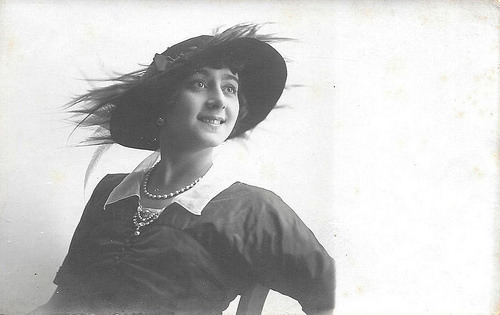
Vera Karalli . Russian postcard. Collection: Didier Hanson.
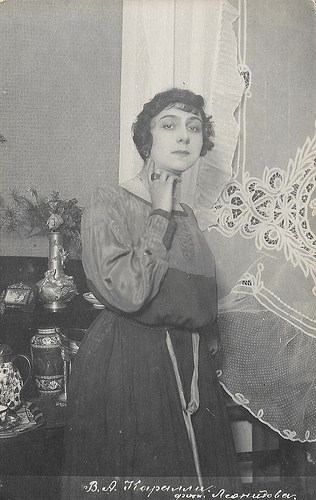
Vera Karalli . Russian postcard. Collection: Didier Hanson.
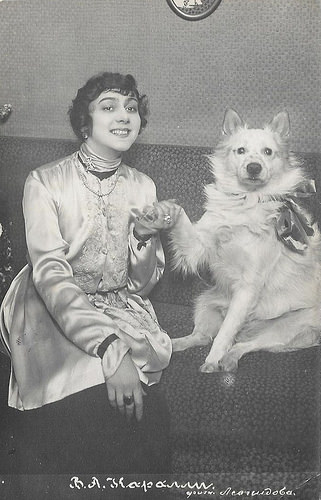
Vera Karalli . Russian postcard. Collection: Didier Hanson.
Vera Karalli (1889-1972) was a Russian ballet dancer, choreographer and actress in the early 20th century.
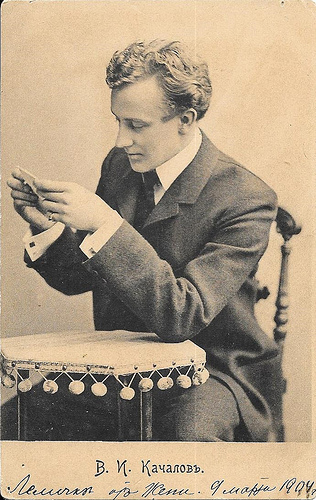
Vasili Kachalov. Russian postcard. Sent by mail in 1904. Collection: Didier Hanson.
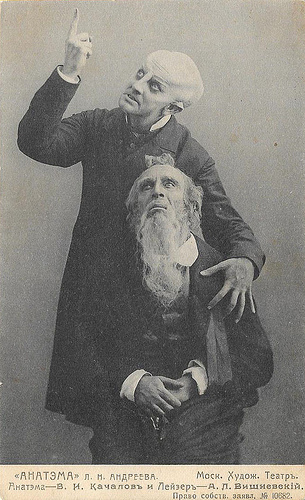
Vasili Kachalov. Russian postcard, no. 10682. Photo: publicity still for the stage play Anathema (1909) at The Moscow Art Theatre, Moscow, Russia. Collection: Didier Hanson.
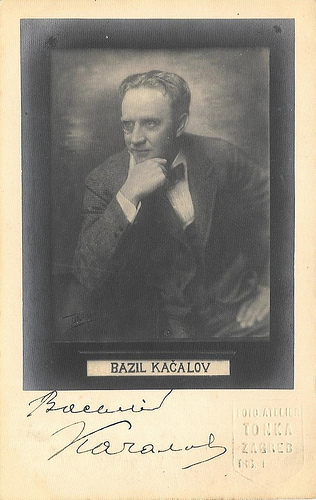
Vasili Kachalov. Yugoslavian postcard. Photo: Foto Atelier Tonka, Zagreb. Collection: Didier Hanson.
Russian film and stage actor Vasili Kachalov (1875-1948) was one of Konstantin Stanislavsky's best known performers. He led the so-called Kachalov Group within the Moscow Art Theatre. He also appeared in four films.
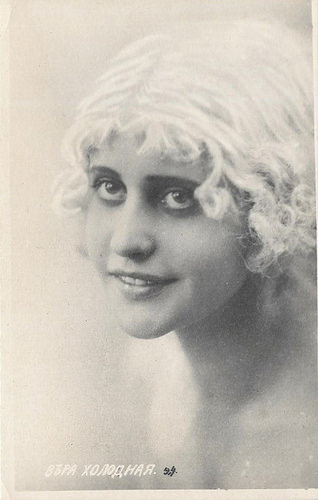
Vera Kholodnaya . Russian postcard, no. 24. Collection: Didier Hanson.
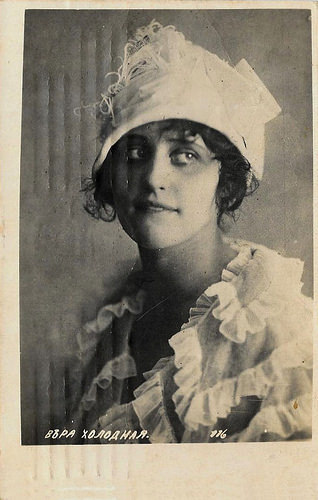
Vera Kholodnaya . Russian postcard, no. 116. Collection: Didier Hanson.
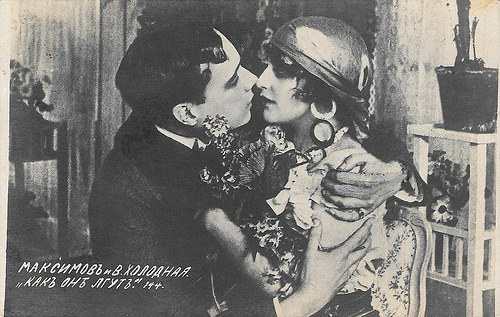
Vera Kholodnaya and Vladimir Maksimov . Russian postcard, no. 144. Collection: Didier Hanson.
Vera Kholodnaya (1893-1919) was the first star of the Russian silent cinema. Only 26, the ‘Queen of Screen’ died of the Spanish flu during the pandemic of 1919. Although she worked only three years for the cinema, she must have made between fifty and hundred short films. The Soviet authorities ordered to destroy many of the Kholodnaya features in 1924, and only five of her films still exist.
Russian actor Vladimir Maksimov (1880-1937) was known for Skorb beskonechnaya/Infinite Sorrow (Aleksandr Panteleyev, 1922), Katsi katsistvis mgelia/Man Is Enemy (Ivane Perestiani, 1923) and Dekabristy/The Decembrists (Aleksandr Ivanovsky, 1927). He died in 1937 in Moscow, Soviet Union.
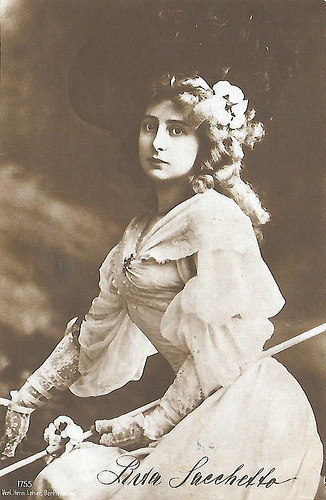
Rita Sacchetto . German Postcard by Verlag Hermann Leiser, Berlin, no. 1755. Collection: Didier Hanson.
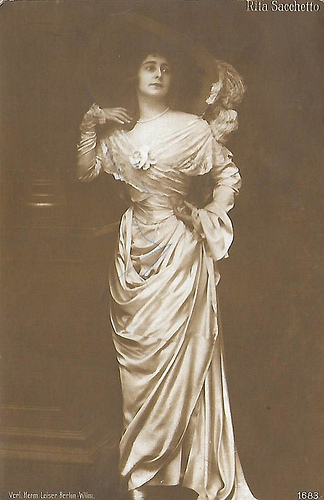
Rita Sacchetto . German Postcard by Verlag Hermann Leiser, Berlin, no. 1683. Collection: Didier Hanson.
German actress and dancer Rita Sacchetto (1879-1959) was in the 1910s a star of the Danish Nordisk Film Company.
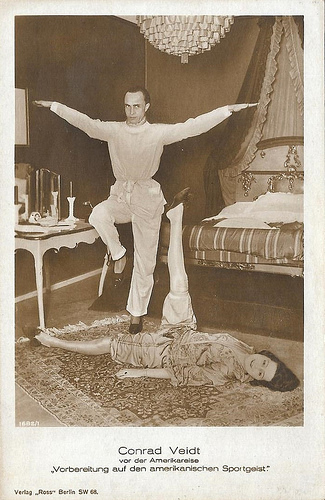
German postcard by Ross Verlag, no. 1682/1. Collection: Didier Hanson. Conrad Veidt preparing for his first trip to the United States and poking fun at the American sport spirit. In 1926 Veidt went to Hollywood to act in films like The Beloved Rogue (1927) and The Man Who Laughs (1928). The woman is probably his then wife Felicitas Radke. They were married from 1923 till 1932.
Thanks, Didier! This is a post for Postcard Friendship Friday, hosted by Beth at the The Best Hearts are Crunchy. You can visit her by clicking on the button below.


Vera Karalli . Russian postcard. Collection: Didier Hanson.

Vera Karalli . Russian postcard. Collection: Didier Hanson.

Vera Karalli . Russian postcard. Collection: Didier Hanson.
Vera Karalli (1889-1972) was a Russian ballet dancer, choreographer and actress in the early 20th century.

Vasili Kachalov. Russian postcard. Sent by mail in 1904. Collection: Didier Hanson.

Vasili Kachalov. Russian postcard, no. 10682. Photo: publicity still for the stage play Anathema (1909) at The Moscow Art Theatre, Moscow, Russia. Collection: Didier Hanson.

Vasili Kachalov. Yugoslavian postcard. Photo: Foto Atelier Tonka, Zagreb. Collection: Didier Hanson.
Russian film and stage actor Vasili Kachalov (1875-1948) was one of Konstantin Stanislavsky's best known performers. He led the so-called Kachalov Group within the Moscow Art Theatre. He also appeared in four films.

Vera Kholodnaya . Russian postcard, no. 24. Collection: Didier Hanson.

Vera Kholodnaya . Russian postcard, no. 116. Collection: Didier Hanson.

Vera Kholodnaya and Vladimir Maksimov . Russian postcard, no. 144. Collection: Didier Hanson.
Vera Kholodnaya (1893-1919) was the first star of the Russian silent cinema. Only 26, the ‘Queen of Screen’ died of the Spanish flu during the pandemic of 1919. Although she worked only three years for the cinema, she must have made between fifty and hundred short films. The Soviet authorities ordered to destroy many of the Kholodnaya features in 1924, and only five of her films still exist.
Russian actor Vladimir Maksimov (1880-1937) was known for Skorb beskonechnaya/Infinite Sorrow (Aleksandr Panteleyev, 1922), Katsi katsistvis mgelia/Man Is Enemy (Ivane Perestiani, 1923) and Dekabristy/The Decembrists (Aleksandr Ivanovsky, 1927). He died in 1937 in Moscow, Soviet Union.

Rita Sacchetto . German Postcard by Verlag Hermann Leiser, Berlin, no. 1755. Collection: Didier Hanson.

Rita Sacchetto . German Postcard by Verlag Hermann Leiser, Berlin, no. 1683. Collection: Didier Hanson.
German actress and dancer Rita Sacchetto (1879-1959) was in the 1910s a star of the Danish Nordisk Film Company.

German postcard by Ross Verlag, no. 1682/1. Collection: Didier Hanson. Conrad Veidt preparing for his first trip to the United States and poking fun at the American sport spirit. In 1926 Veidt went to Hollywood to act in films like The Beloved Rogue (1927) and The Man Who Laughs (1928). The woman is probably his then wife Felicitas Radke. They were married from 1923 till 1932.
Thanks, Didier! This is a post for Postcard Friendship Friday, hosted by Beth at the The Best Hearts are Crunchy. You can visit her by clicking on the button below.

Published on December 31, 2015 22:00
December 30, 2015
Heidi Brühl
Blonde, blue-eyed Schlager singer and film star Heidi Brühl (1942-1991) was called 'the Doris Day of Germany'. In 1963 she was the German participant at the Eurovision Song Contest. In the early 1970s she worked in Hollywood and appeared opposite Clint Eastwood in The Eiger Sanction (1975).
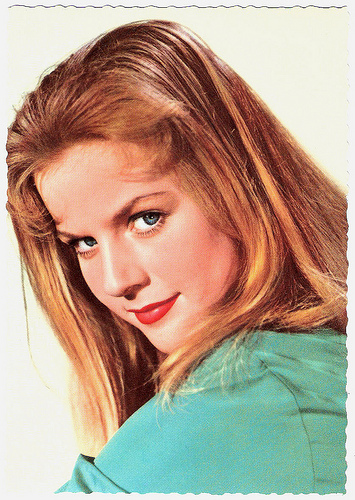
German postcard by Ufa (Universum-Film Aktiengesellschaft, Berlin-Templehof), no. CK-128. Photo: Ringpress / Vogelmann.
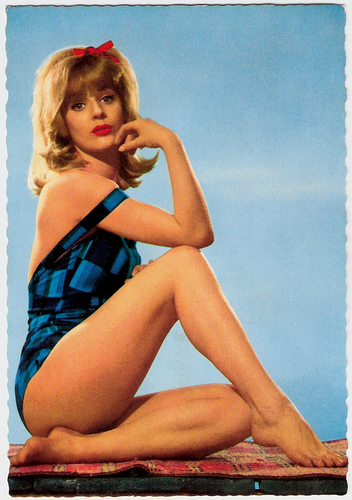
Dutch postcard by P. Moorlag, Heerlen, Sort. 10/6.
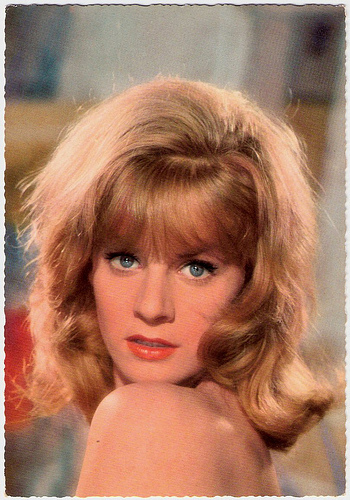
German postcard by Krüger, no. 902/30. Photo: Philips.
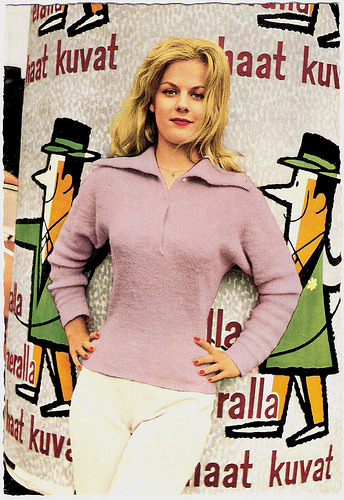
German postcard by WS-Druck, Wanne-Eickel, no. F 154.
Teen Idol
Heidi Rosemarie Brühl was born in Gräfeling near München (Munich), Germany in 1942. After the divorce of her parents, she grew up with her grandparents.
She made her first film when she was only 12. Director Harald Braun had discovered her in a ballet class and cast her for an uncredited bit part in Der letzte Sommer/The Last Summer (Harald Braun, 1954) starring heartthrob Hardy Krüger .
This was followed by a small part in the Heimat-film Heideschulmeister Uwe Karsten/Eternal Love (Hans Deppe, 1954) featuring Claus Holm . A string of these silly romantic rural films made her a teen idol.
Her most popular films were a trilogy based on novels by children's writer Ursula Bruns about the pony farm Immenhof: Die Mädels vom Immenhof/The Girls of Immenhof (Wolfgang Schleif, 1955) with Angelika Meisner and Christiane König as her orphaned sisters, Hochzeit auf Immenhof/Marriage at Immenhof (Volker von Collande, 1956) and Ferien auf Immenhof/Holiday at Immenhof (Hermann Leitner, 1958).

Dutch postcard, no. 14.
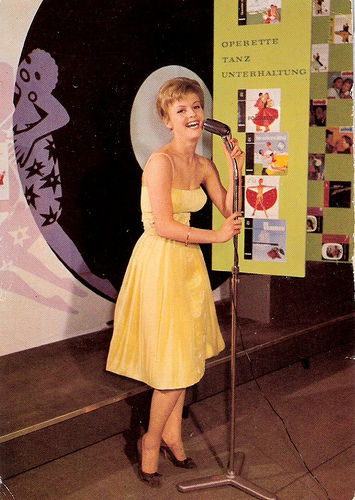
German postcard by ISV, no. H 93.
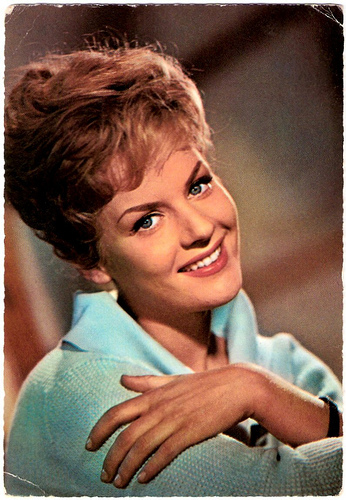
German postcard by ISV, no. H 76, circa 1964.
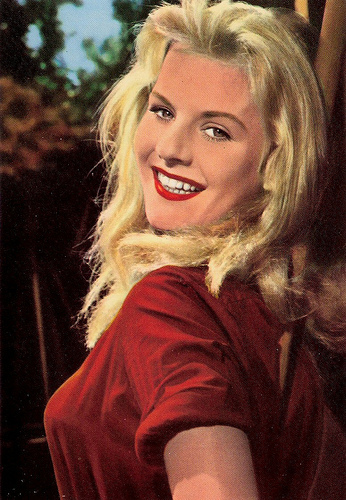
Vintage postcard.
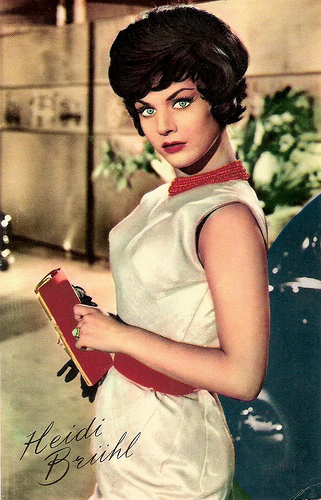
Dutch postcard.
Cute Boys
Heidi Brühl also appeared in the excellent Thomas Mann adaptation Die Bekenntnisse des Hochstaplers Felix Krull/Confessions of Felix Krull (Kurt Hoffmann, 1957) with another German teen idol of the 1950s, Horst Buchholz.
That years, she also starred in Die Frühreifen/The Prematures (Josef von Baky, 1957) with another cute boy Christian Wolff.
She also appeared opposite Wolff in Verbrechen nach Schulschluss/The Young Go Wild (Alfred Vohrer, 1959)
Heidi Brühl then could be seen as a singer in the Schlager-film Schlager-Raketen/Hit-Rockets (Erik Ode, 1960).
She also starred in Freddy und die Melodie der Nacht/Freddy and the Melody of the Night (Wolfgang Schleif, 1960) featuring schlager star Freddy Quinn , and the operetta film Der Zigeuner Baron/The Gypsy Baron (Kurt Wilhelm, 1962) opposite Carlos Thompson .
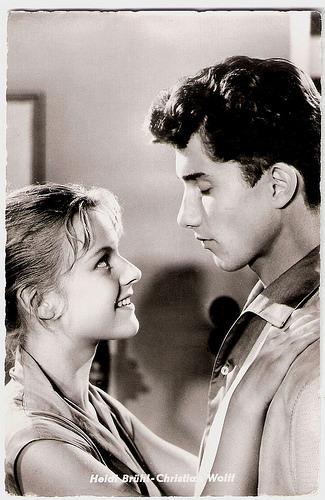
German postcard by Kolibri-Verlag G.m.b.H., Minden/Westf., no. 361. Photo: CCC / Krau. Publicity still for Die Frühreifen/The precocious (Josef von Báky, 1957) with Christian Wolff.
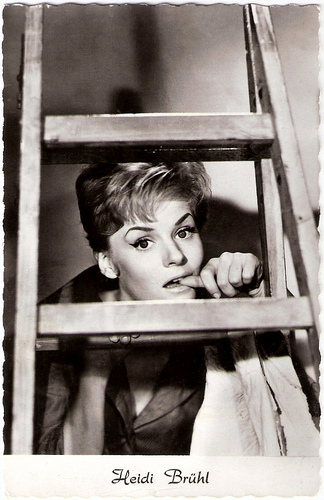
Dutch postcard by Gofilex film, no. 376. Still from Immer will ich dir gehören (Arno Assmann, 1960).
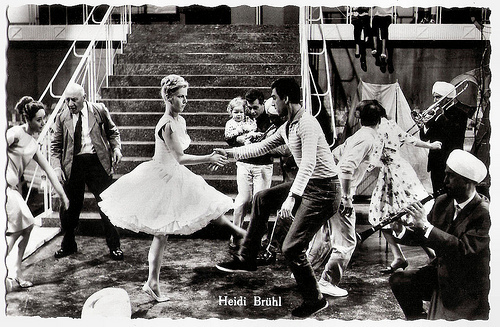
Dutch postcard by N.V. v.h. Weenenk & Snel, Baarn, no. 761. Photo: Gofilex. Publicity still for Immer will ich dich gehören/
Always I will be yours (Arno Assmann, 1960) with Peter Weck .
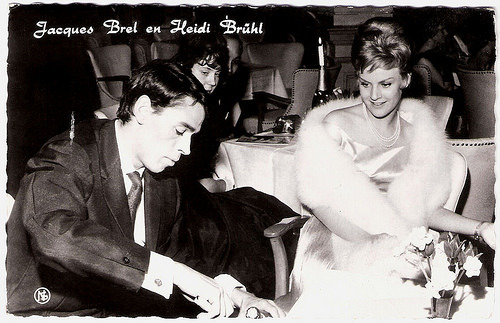
Dutch postcard by NS, no. 12. With Jacques Brel .
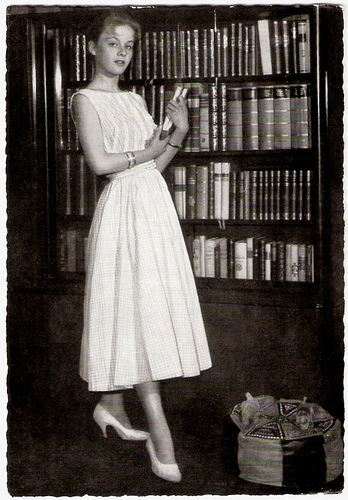
German postcard by WS-Druck, Wanne-Eickel, no. 199. Photo: Ringpress / Vogelmann / NDF.
A Cool Blonde
At the age of 16, Heidi Brühl decided to go back to school and studied singing, dancing, acting, English and French.
In 1959 she formed a Schlager duo, the Dolly Sisters together with Corina Corten. They obtained a record deal with the Philips label, and their first record Chico Chico Charlie reached the no. 5 position in the German hit parade.
In 1960 she wanted to enter the Eurovision Song Contest solo with Wir wollen niemals auseinandergehn (We will never part), but she finished in second place. The song became her biggest hit though. It reached no. 1 in the German single charts, stayed there for nine weeks and sold more than a million copies. The song was a cover of Doris Day's Ring of Gold, and she was nicknamed the 'Doris Day of Germany'.
She participated again at the German pre-selection in 1963, and this time she was successful and joined the Eurovision Song Contest in London. She became 9th with the song Marcel.
Till 1967 she had 12 hits in Germany. She did not make films in Germany during this period, but she appeared on stage in musicals like Annie Get Your Gun (1964) and My Fair Lady (1969).
That year she also published the memoir Eine kühle Blonde bitte. Erinnerungen eines bisweilen unvorsichtigen Mädchens (A cool blonde, please. Recollections of a sometimes careless girl) (1969).
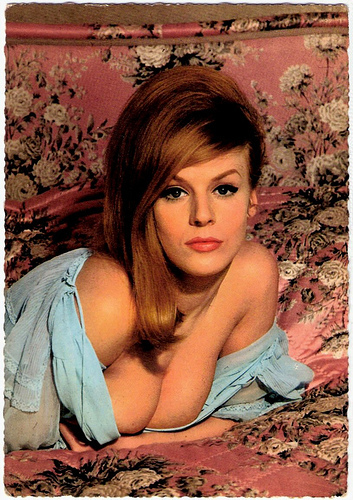
German postcard by Kruger, no. 903/321. This photo and those below are all made by the master of the pin-up pics, Bernard of Hollywood . Click twice on the picture to see them in a bigger format.
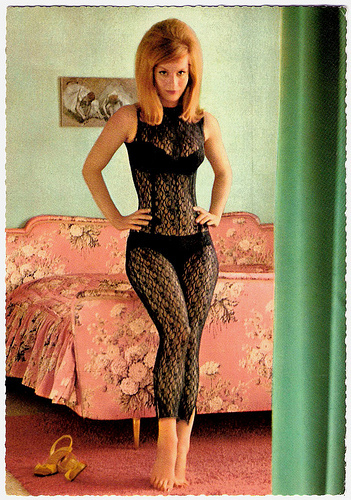
German postcard by Krüger, no. 902/322. Photo: Bernard of Hollywood.
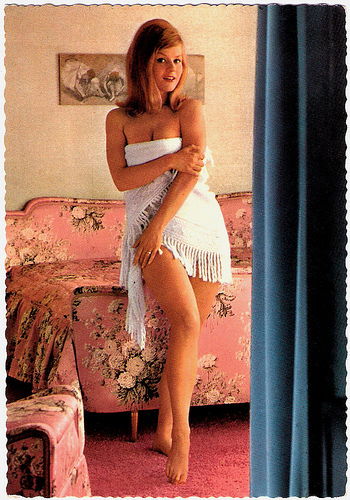
German postcard by Krüger, no. 902/319. Photo: Bernard of Hollywood.
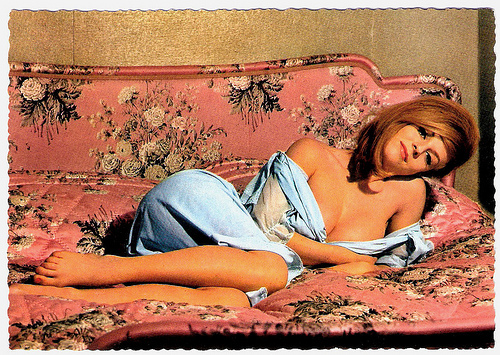
German postcard by Krüger, no. 902/323. Photo: Bernard of Hollywood.
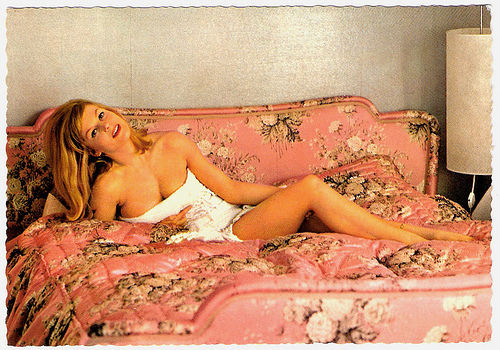
German postcard by Krüger, no. 902/330. Photo: Bernard of Hollywood.
Breast Cancer
When Heidi Brühl was on a concert tour in the US she was asked to play Princess Jana opposite Guy Williams in MGM's Captain Sindbad (Byron Haskin, 1963), but the movie flopped.
Brühl met American actor Brett Halsey, and moved with him to Rome, where they married in December 1964. She did not make any films while she lived in Rome.
In the 1970s the family moved to the US, where she acted in the deadly dull comedy How to Seduce a Woman (Charles Martin, 1974) and appeared opposite Clint Eastwood in a small part in the adventure film The Eiger Sanction (Clint Eastwood, 1975).
She also worked for TV and was a guest star in such popular crime series as Columbo (1973) starring Peter Falk, Get Christie Love! (1974-1975) starring Teresa Graves, and Marcus Welby, M.D. (1976) with James Brolin. In Las Vegas she performed together with Sammy Davis Jr.
In between she returned to Germany to play in two further Immenhof sequels, Zwillinge vom Immenhof/Twins from Immen Farm (Wolfgang Schleif, 1973) with Horst Janson , and Frühling auf Immenhof/Spring at Immen Farm (Wolfgang Schleif, 1974) with Olga Tschechova. Both were flops.
In 1976 she divorced Halsey and returned to Germany. There she worked mainly for TV, such as in Krimi series as Der Alte/The Old Fox (1985) starring Michael Ande, and Ein Fall für zwei/A Case for Two (1984, 1987) with Claus Theo Gärtner. She also did dubbing work on films such as The NeverEnding Story and Look Who's Talking Too, and in 1982 she started a record studio.
Her final film appearance was as a civil servant in the immigration drama Kleiner Mann was tun/Little man What To Do (Uschi Madeisky, Klaus Werner, 1981).
When she was 20, Heidi Brühl had been diagnosed with stomach cancer, but had defeated the disease. In the late 1980s she got breast cancer but this time she had to surrender and refused chemotherapy.
Heidi Brühl passed away in 1991 in Starnberg, Germany, only 49 years old. She had two children. Her son Clayton Halsey (1967) is an editor and actor, and her daughter Nicole Brühl-Halsey (1970) is an actress.
Scenes from Die Mädels vom Immenhof/The Girls of Immenhof (1955) (No subtitles). Source: Kanaal van fifteesrebel (YouTube).
TV trailer for Die Bekenntnisse des Hochstaplers Felix Krull/Confessions of Felix Krull (1957). Source: ANIXE (YouTube).
Heidi Brühl sings Marcel at the Eurovision Song Contest of 1963. Source: escbelgium3 | 1956 - 1979 (YouTube).
Heidi Brühl sings Wir wollen niemals auseinandergehen. Source: Schlageria (YouTube).
Trailer of The Eiger Sanction (1975). Source: Pick Of The Flicks Tony (YouTube). (You can only see a glimpse of Heidi).
Sources: Stephanie D'heil (Steffi-line) (German), Filmportal.de, Prisma (German) Wikipedia (German) and .

German postcard by Ufa (Universum-Film Aktiengesellschaft, Berlin-Templehof), no. CK-128. Photo: Ringpress / Vogelmann.

Dutch postcard by P. Moorlag, Heerlen, Sort. 10/6.

German postcard by Krüger, no. 902/30. Photo: Philips.

German postcard by WS-Druck, Wanne-Eickel, no. F 154.
Teen Idol
Heidi Rosemarie Brühl was born in Gräfeling near München (Munich), Germany in 1942. After the divorce of her parents, she grew up with her grandparents.
She made her first film when she was only 12. Director Harald Braun had discovered her in a ballet class and cast her for an uncredited bit part in Der letzte Sommer/The Last Summer (Harald Braun, 1954) starring heartthrob Hardy Krüger .
This was followed by a small part in the Heimat-film Heideschulmeister Uwe Karsten/Eternal Love (Hans Deppe, 1954) featuring Claus Holm . A string of these silly romantic rural films made her a teen idol.
Her most popular films were a trilogy based on novels by children's writer Ursula Bruns about the pony farm Immenhof: Die Mädels vom Immenhof/The Girls of Immenhof (Wolfgang Schleif, 1955) with Angelika Meisner and Christiane König as her orphaned sisters, Hochzeit auf Immenhof/Marriage at Immenhof (Volker von Collande, 1956) and Ferien auf Immenhof/Holiday at Immenhof (Hermann Leitner, 1958).

Dutch postcard, no. 14.

German postcard by ISV, no. H 93.

German postcard by ISV, no. H 76, circa 1964.

Vintage postcard.

Dutch postcard.
Cute Boys
Heidi Brühl also appeared in the excellent Thomas Mann adaptation Die Bekenntnisse des Hochstaplers Felix Krull/Confessions of Felix Krull (Kurt Hoffmann, 1957) with another German teen idol of the 1950s, Horst Buchholz.
That years, she also starred in Die Frühreifen/The Prematures (Josef von Baky, 1957) with another cute boy Christian Wolff.
She also appeared opposite Wolff in Verbrechen nach Schulschluss/The Young Go Wild (Alfred Vohrer, 1959)
Heidi Brühl then could be seen as a singer in the Schlager-film Schlager-Raketen/Hit-Rockets (Erik Ode, 1960).
She also starred in Freddy und die Melodie der Nacht/Freddy and the Melody of the Night (Wolfgang Schleif, 1960) featuring schlager star Freddy Quinn , and the operetta film Der Zigeuner Baron/The Gypsy Baron (Kurt Wilhelm, 1962) opposite Carlos Thompson .

German postcard by Kolibri-Verlag G.m.b.H., Minden/Westf., no. 361. Photo: CCC / Krau. Publicity still for Die Frühreifen/The precocious (Josef von Báky, 1957) with Christian Wolff.

Dutch postcard by Gofilex film, no. 376. Still from Immer will ich dir gehören (Arno Assmann, 1960).

Dutch postcard by N.V. v.h. Weenenk & Snel, Baarn, no. 761. Photo: Gofilex. Publicity still for Immer will ich dich gehören/
Always I will be yours (Arno Assmann, 1960) with Peter Weck .

Dutch postcard by NS, no. 12. With Jacques Brel .

German postcard by WS-Druck, Wanne-Eickel, no. 199. Photo: Ringpress / Vogelmann / NDF.
A Cool Blonde
At the age of 16, Heidi Brühl decided to go back to school and studied singing, dancing, acting, English and French.
In 1959 she formed a Schlager duo, the Dolly Sisters together with Corina Corten. They obtained a record deal with the Philips label, and their first record Chico Chico Charlie reached the no. 5 position in the German hit parade.
In 1960 she wanted to enter the Eurovision Song Contest solo with Wir wollen niemals auseinandergehn (We will never part), but she finished in second place. The song became her biggest hit though. It reached no. 1 in the German single charts, stayed there for nine weeks and sold more than a million copies. The song was a cover of Doris Day's Ring of Gold, and she was nicknamed the 'Doris Day of Germany'.
She participated again at the German pre-selection in 1963, and this time she was successful and joined the Eurovision Song Contest in London. She became 9th with the song Marcel.
Till 1967 she had 12 hits in Germany. She did not make films in Germany during this period, but she appeared on stage in musicals like Annie Get Your Gun (1964) and My Fair Lady (1969).
That year she also published the memoir Eine kühle Blonde bitte. Erinnerungen eines bisweilen unvorsichtigen Mädchens (A cool blonde, please. Recollections of a sometimes careless girl) (1969).

German postcard by Kruger, no. 903/321. This photo and those below are all made by the master of the pin-up pics, Bernard of Hollywood . Click twice on the picture to see them in a bigger format.

German postcard by Krüger, no. 902/322. Photo: Bernard of Hollywood.

German postcard by Krüger, no. 902/319. Photo: Bernard of Hollywood.

German postcard by Krüger, no. 902/323. Photo: Bernard of Hollywood.

German postcard by Krüger, no. 902/330. Photo: Bernard of Hollywood.
Breast Cancer
When Heidi Brühl was on a concert tour in the US she was asked to play Princess Jana opposite Guy Williams in MGM's Captain Sindbad (Byron Haskin, 1963), but the movie flopped.
Brühl met American actor Brett Halsey, and moved with him to Rome, where they married in December 1964. She did not make any films while she lived in Rome.
In the 1970s the family moved to the US, where she acted in the deadly dull comedy How to Seduce a Woman (Charles Martin, 1974) and appeared opposite Clint Eastwood in a small part in the adventure film The Eiger Sanction (Clint Eastwood, 1975).
She also worked for TV and was a guest star in such popular crime series as Columbo (1973) starring Peter Falk, Get Christie Love! (1974-1975) starring Teresa Graves, and Marcus Welby, M.D. (1976) with James Brolin. In Las Vegas she performed together with Sammy Davis Jr.
In between she returned to Germany to play in two further Immenhof sequels, Zwillinge vom Immenhof/Twins from Immen Farm (Wolfgang Schleif, 1973) with Horst Janson , and Frühling auf Immenhof/Spring at Immen Farm (Wolfgang Schleif, 1974) with Olga Tschechova. Both were flops.
In 1976 she divorced Halsey and returned to Germany. There she worked mainly for TV, such as in Krimi series as Der Alte/The Old Fox (1985) starring Michael Ande, and Ein Fall für zwei/A Case for Two (1984, 1987) with Claus Theo Gärtner. She also did dubbing work on films such as The NeverEnding Story and Look Who's Talking Too, and in 1982 she started a record studio.
Her final film appearance was as a civil servant in the immigration drama Kleiner Mann was tun/Little man What To Do (Uschi Madeisky, Klaus Werner, 1981).
When she was 20, Heidi Brühl had been diagnosed with stomach cancer, but had defeated the disease. In the late 1980s she got breast cancer but this time she had to surrender and refused chemotherapy.
Heidi Brühl passed away in 1991 in Starnberg, Germany, only 49 years old. She had two children. Her son Clayton Halsey (1967) is an editor and actor, and her daughter Nicole Brühl-Halsey (1970) is an actress.
Scenes from Die Mädels vom Immenhof/The Girls of Immenhof (1955) (No subtitles). Source: Kanaal van fifteesrebel (YouTube).
TV trailer for Die Bekenntnisse des Hochstaplers Felix Krull/Confessions of Felix Krull (1957). Source: ANIXE (YouTube).
Heidi Brühl sings Marcel at the Eurovision Song Contest of 1963. Source: escbelgium3 | 1956 - 1979 (YouTube).
Heidi Brühl sings Wir wollen niemals auseinandergehen. Source: Schlageria (YouTube).
Trailer of The Eiger Sanction (1975). Source: Pick Of The Flicks Tony (YouTube). (You can only see a glimpse of Heidi).
Sources: Stephanie D'heil (Steffi-line) (German), Filmportal.de, Prisma (German) Wikipedia (German) and .
Published on December 30, 2015 22:00
December 29, 2015
Imported from the USA: George Chakiris
American dancer, singer and actor George Chakiris (1934) had his biggest success as Bernardo, the leader of the Sharks gang in the celebrated film musical West Side Story (1961). Later he starred with Catherine Deneuve in another classic, the charming French musical Les Demoiselles de Rochefort (1967).From now, our weekly series Imported from the USA will be posted on Wednesday.
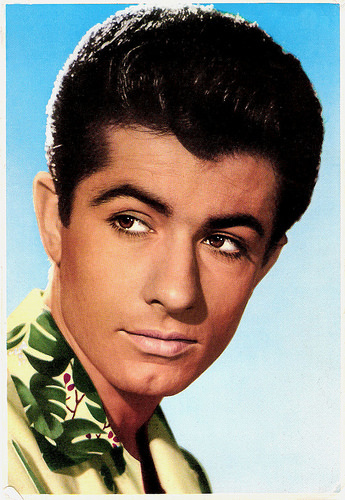
Spanish postcard by Archivo Bermejo, no. C. 178. Photo: United Artists. Publicity still for West Side Story (Robert Wise, 1961).
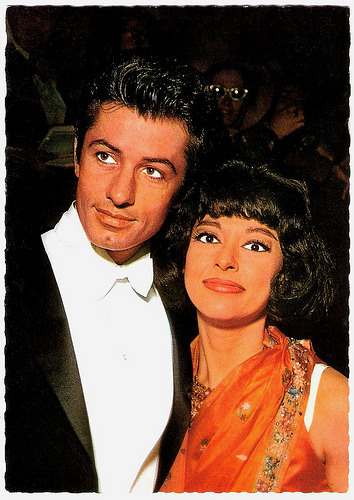
Dutch postcard by Gebr. Spanjersberg NV, Rotterdam. Photo: Capitol. Publicity still for West Side Story (Robert Wise, 1961) with Rita Moreno.
Silky yet explosive dancing
George Chakiris was born in Norwood, Ohio, in 1934. His parents were Steven and Zoe (née Anastasiadou) Chakiris, immigrants from Greece.
Chakiris studied at the American School of Dance. He made his film debut at the age of 12 singing in the chorus of Song of Love (Clarence Brown, 1947), a biopic of Robert and Clara Schumann (Robert Walker and Katharine Hepburn).
Following his graduation from high school, he supported his night-time dancing, singing and dramatic lessons with a daytime job clerking in a Los Angeles department store. For several years he appeared in small, unbilled roles, usually as a dancer or a member of the chorus in various musical films.
He was one of the tuxedoed dancers in Marilyn Monroe's Diamonds Are a Girl's Best Friend number in Gentlemen Prefer Blondes (Howard Hawks, 1953), and appeared as a dancer alongside Rosemary Clooney in White Christmas (Michael Curtiz, 1954) in the Love, You Didn't Do Right by Me number. He can also be seen in the funeral dance in the MGM musical Brigadoon (Vincente Minnelli, 1954).
In 1957, he made his debut as a dramatic actor in a small part in the war drama Under Fire (James B. Clarke, 1957). The following year, he travelled to New York hoping for a Broadway ‘break.’ Hearing that Jerome Robbins was casting the London company of West Side Story, he auditioned and was awarded the co-starring role of Riff, leader of the Anglo gang, the Jets. He played the part for almost two years on the West End stage.
Chakiris also co-starred in the film version, West Side Story (Robert Wise, 1961). He now played Bernardo, leader of a rival Puerto Rican gang of immigrants, the Sharks. For this magnetic role and his silky yet explosive dancing, he won the Academy Award for Best Supporting Actor and a Golden Globe. The romantic musical drama became the second highest grossing film of the year in the United States. West Side Story was nominated for 11 Academy Awards and won 10, including Best Picture.
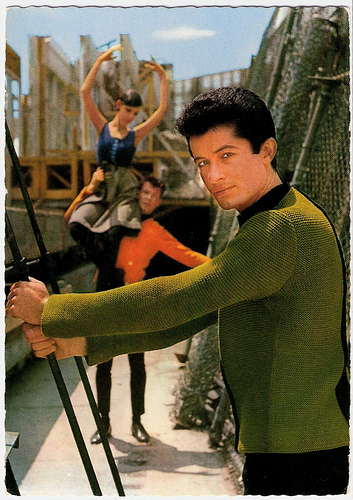
Dutch postcard by Gebr. Spanjersberg N.V., Rotterdam, no. 1. Photo: Capitol.
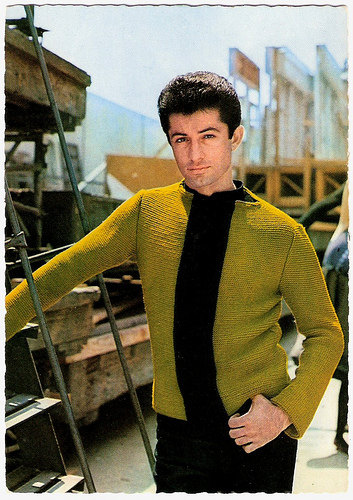
Dutch postcard by Gebr. Spanjersberg N.V., Rotterdam, no. 3. Photo: Capitol.
Gorgeous and a delight to the eye
During the rest of the 1960s, George Chakiris was in much demand. He starred as a doctor in the film Diamond Head (Guy Green, 1963) opposite Charlton Heston and Yvette Mimieux, and appeared alongside Yul Brynner in Kings of the Sun (J. Lee Thompson, 1963) and Flight from Ashiya (Michael Anderson, 1964).
His fee around this time was a reported $100,000 per film. In Italy he starred opposite Claudia Cardinale in the crime film La ragazza di Bube/Bebo’s Girl (Luigi Comencini,1963).
Later he acted in France along with Catherine Deneuve and her sister Françoise Dorléac in the musical Les Demoiselles de Rochefort/The Young Ladies of Rochefort (Jacques Demy, 1967).
Craig Butler at AllMovie : “When originally released, Jacques Demy's The Young Girls of Rochefort suffered in comparison with his earlier The Umbrellas of Cherbourg, but its reputation has grown in the intervening years. Although not without flaws, Rochefort is a tremendously appealing and utterly engaging musical trifle. Breezy and light, Rochefort is also gorgeous and a delight to the eye; Demy's sense and use of color is practically overwhelming, and is as important to the success of the film as any other element.”
In France, he also appeared in the spy comedy Le Rouble à deux faces/The Day the Hot Line Got Hot (Etienne Périer, 1968) starring Robert Taylor and Charles Boyer . In addition to film, Chakiris performed on stage in London and around the U.S. and on television. In the early 1960s, he embarked on a career as a pop singer, resulting in a couple of minor hit songs. In 1960, he recorded one single with noted producer Joe Meek.
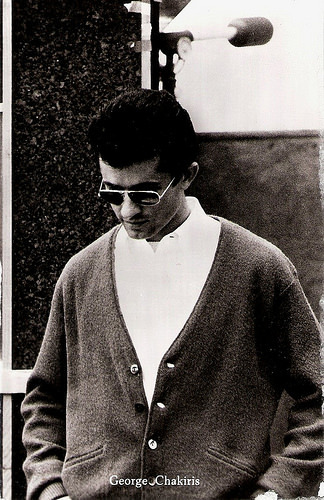
Dutch postcard by Hercules, Haarlem, no. 1089. Photo: Capitol.
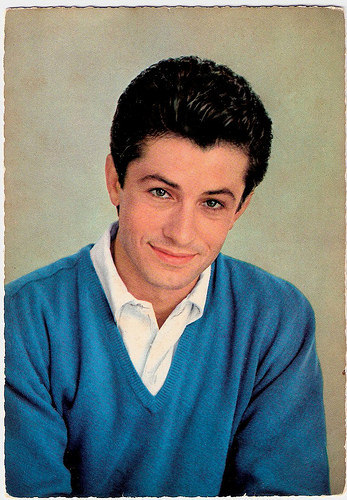
German postcard by Krüger, no. 902/248.
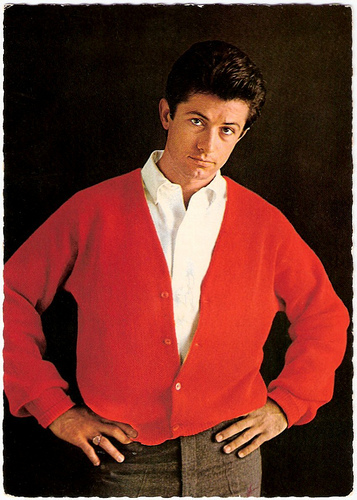
Dutch postcard by Gebr. Spanjersberg N.V., Rotterdam. Photo: Capitol. Publicity still for West Side Story (Robert Wise, 1961|).
Heels or middle-aged Lotharios
George Chakiris starred in the first national tour of the Stephen Sondheim musical, Company, touring as Bobby in 1971-72.
He worked more in television in the 1970s and 1980s. His television credits include a leading role in an adaptation of Kismet (1967) with Anna Maria Alberghetti and Jose Ferrer, and a co-starring stint with Rosemary Harris and Jeremy Irons in the British historical miniseries Notorious Woman (Waris Hussein, 1975), a dramatisation of the life of author George Sand.
Chakiris also played character turns as heels or middle-aged Lotharios on such series as Medical Center (1970-1975), Hawaii Five-O (1972), Wonder Woman (1978), Dallas (1986), Murder, She Wrote (1989), and the daytime soap opera Santa Barbara (1988).
He also appeared in the final episode of The Partridge Family (1974) as an old flame to Shirley Partridge (Shirley Jones). Their kiss goodbye was the final scene in the program's run. Chakiris had a recurring role on the TV show Superboy as Professor Peterson during the first two seasons from 1988-1990.
His final film role was as a vampire in Pale Blood (V.V. Dachin Hsu, 1990). Chakiris' last screen role was in a 1996 episode of the sitcom Last of the Summer Wine. He has given occasional television interviews since then, but is mostly retired.
His hobby of making sterling silver jewelry has turned into a new occupation, working as a jewelry designer for his own brand, George Chakiris Collections, consisting of handmade original sterling silver jewelry.
Marilyn Monroe - and George Chakiris - in Diamonds Are a Girl's Best Friend in Gentlemen Prefer Blondes (Howard Hawks, 1953). Source: Marilyn Monroe Diamond (YouTube).
DVD Trailer for West Side Story (Robert Wise, 1961). Source: zuguidemovietrailers (YouTube).
Musical scene from Les Demoiselles de Rochefort/The Young Ladies of Rochefort (Jacques Demy, 1967). Sorry, no subtitles! Source: Marco Siebel (YouTube).
Sources: Hal Erickson (AllMovie), Craig Butler (AllMovie), K. Wiebe (IMDb), TCM, Wikipedia and IMDb.

Spanish postcard by Archivo Bermejo, no. C. 178. Photo: United Artists. Publicity still for West Side Story (Robert Wise, 1961).

Dutch postcard by Gebr. Spanjersberg NV, Rotterdam. Photo: Capitol. Publicity still for West Side Story (Robert Wise, 1961) with Rita Moreno.
Silky yet explosive dancing
George Chakiris was born in Norwood, Ohio, in 1934. His parents were Steven and Zoe (née Anastasiadou) Chakiris, immigrants from Greece.
Chakiris studied at the American School of Dance. He made his film debut at the age of 12 singing in the chorus of Song of Love (Clarence Brown, 1947), a biopic of Robert and Clara Schumann (Robert Walker and Katharine Hepburn).
Following his graduation from high school, he supported his night-time dancing, singing and dramatic lessons with a daytime job clerking in a Los Angeles department store. For several years he appeared in small, unbilled roles, usually as a dancer or a member of the chorus in various musical films.
He was one of the tuxedoed dancers in Marilyn Monroe's Diamonds Are a Girl's Best Friend number in Gentlemen Prefer Blondes (Howard Hawks, 1953), and appeared as a dancer alongside Rosemary Clooney in White Christmas (Michael Curtiz, 1954) in the Love, You Didn't Do Right by Me number. He can also be seen in the funeral dance in the MGM musical Brigadoon (Vincente Minnelli, 1954).
In 1957, he made his debut as a dramatic actor in a small part in the war drama Under Fire (James B. Clarke, 1957). The following year, he travelled to New York hoping for a Broadway ‘break.’ Hearing that Jerome Robbins was casting the London company of West Side Story, he auditioned and was awarded the co-starring role of Riff, leader of the Anglo gang, the Jets. He played the part for almost two years on the West End stage.
Chakiris also co-starred in the film version, West Side Story (Robert Wise, 1961). He now played Bernardo, leader of a rival Puerto Rican gang of immigrants, the Sharks. For this magnetic role and his silky yet explosive dancing, he won the Academy Award for Best Supporting Actor and a Golden Globe. The romantic musical drama became the second highest grossing film of the year in the United States. West Side Story was nominated for 11 Academy Awards and won 10, including Best Picture.

Dutch postcard by Gebr. Spanjersberg N.V., Rotterdam, no. 1. Photo: Capitol.

Dutch postcard by Gebr. Spanjersberg N.V., Rotterdam, no. 3. Photo: Capitol.
Gorgeous and a delight to the eye
During the rest of the 1960s, George Chakiris was in much demand. He starred as a doctor in the film Diamond Head (Guy Green, 1963) opposite Charlton Heston and Yvette Mimieux, and appeared alongside Yul Brynner in Kings of the Sun (J. Lee Thompson, 1963) and Flight from Ashiya (Michael Anderson, 1964).
His fee around this time was a reported $100,000 per film. In Italy he starred opposite Claudia Cardinale in the crime film La ragazza di Bube/Bebo’s Girl (Luigi Comencini,1963).
Later he acted in France along with Catherine Deneuve and her sister Françoise Dorléac in the musical Les Demoiselles de Rochefort/The Young Ladies of Rochefort (Jacques Demy, 1967).
Craig Butler at AllMovie : “When originally released, Jacques Demy's The Young Girls of Rochefort suffered in comparison with his earlier The Umbrellas of Cherbourg, but its reputation has grown in the intervening years. Although not without flaws, Rochefort is a tremendously appealing and utterly engaging musical trifle. Breezy and light, Rochefort is also gorgeous and a delight to the eye; Demy's sense and use of color is practically overwhelming, and is as important to the success of the film as any other element.”
In France, he also appeared in the spy comedy Le Rouble à deux faces/The Day the Hot Line Got Hot (Etienne Périer, 1968) starring Robert Taylor and Charles Boyer . In addition to film, Chakiris performed on stage in London and around the U.S. and on television. In the early 1960s, he embarked on a career as a pop singer, resulting in a couple of minor hit songs. In 1960, he recorded one single with noted producer Joe Meek.

Dutch postcard by Hercules, Haarlem, no. 1089. Photo: Capitol.

German postcard by Krüger, no. 902/248.

Dutch postcard by Gebr. Spanjersberg N.V., Rotterdam. Photo: Capitol. Publicity still for West Side Story (Robert Wise, 1961|).
Heels or middle-aged Lotharios
George Chakiris starred in the first national tour of the Stephen Sondheim musical, Company, touring as Bobby in 1971-72.
He worked more in television in the 1970s and 1980s. His television credits include a leading role in an adaptation of Kismet (1967) with Anna Maria Alberghetti and Jose Ferrer, and a co-starring stint with Rosemary Harris and Jeremy Irons in the British historical miniseries Notorious Woman (Waris Hussein, 1975), a dramatisation of the life of author George Sand.
Chakiris also played character turns as heels or middle-aged Lotharios on such series as Medical Center (1970-1975), Hawaii Five-O (1972), Wonder Woman (1978), Dallas (1986), Murder, She Wrote (1989), and the daytime soap opera Santa Barbara (1988).
He also appeared in the final episode of The Partridge Family (1974) as an old flame to Shirley Partridge (Shirley Jones). Their kiss goodbye was the final scene in the program's run. Chakiris had a recurring role on the TV show Superboy as Professor Peterson during the first two seasons from 1988-1990.
His final film role was as a vampire in Pale Blood (V.V. Dachin Hsu, 1990). Chakiris' last screen role was in a 1996 episode of the sitcom Last of the Summer Wine. He has given occasional television interviews since then, but is mostly retired.
His hobby of making sterling silver jewelry has turned into a new occupation, working as a jewelry designer for his own brand, George Chakiris Collections, consisting of handmade original sterling silver jewelry.
Marilyn Monroe - and George Chakiris - in Diamonds Are a Girl's Best Friend in Gentlemen Prefer Blondes (Howard Hawks, 1953). Source: Marilyn Monroe Diamond (YouTube).
DVD Trailer for West Side Story (Robert Wise, 1961). Source: zuguidemovietrailers (YouTube).
Musical scene from Les Demoiselles de Rochefort/The Young Ladies of Rochefort (Jacques Demy, 1967). Sorry, no subtitles! Source: Marco Siebel (YouTube).
Sources: Hal Erickson (AllMovie), Craig Butler (AllMovie), K. Wiebe (IMDb), TCM, Wikipedia and IMDb.
Published on December 29, 2015 22:00
December 28, 2015
Michèle Morgan, Part 2
Blond actress Michèle Morgan (1920) was a classic beauty. She has been one of the most popular leading ladies of the French cinema for over five decades. The delicate, sophisticated star was especially noted for her large, expressive eyes. Today, Part Two of a double post on her long career and her many postcards.
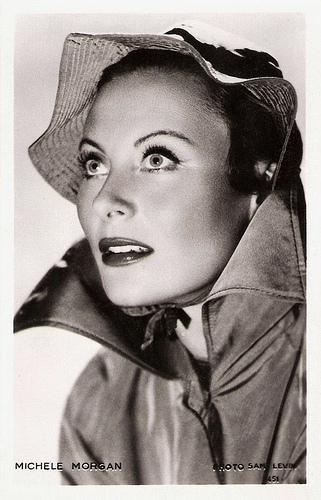
French postcard by Editions P.I., Paris, no. 451. Photo: Sam Lévin.
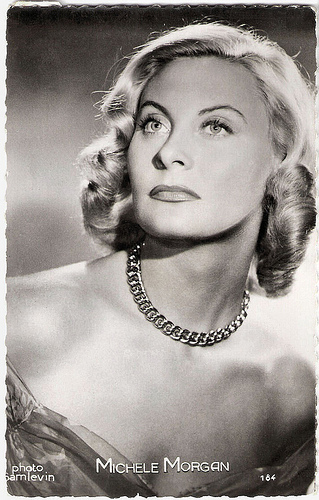
French postcard by Editions P.I., Paris, no. 184. Photo: Sam Lévin.
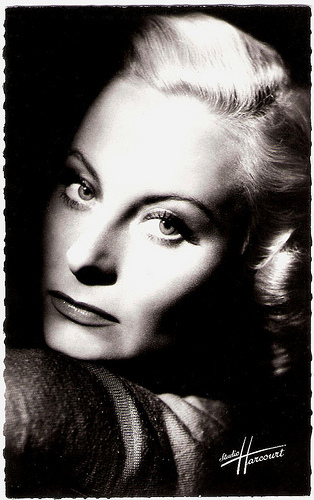
French postcard by Editions du Globe (E.D.U.G.), no. 66. Photo: Studio Harcourt.
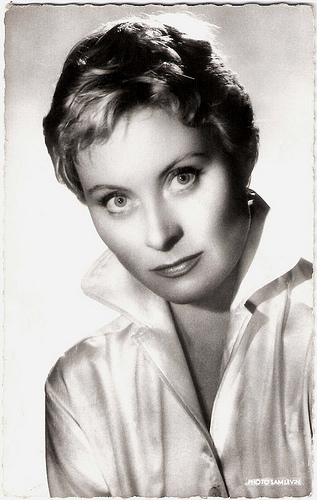
French postcard by Editions du Globe, Paris, no. 616. Photo: Sam Lévin.
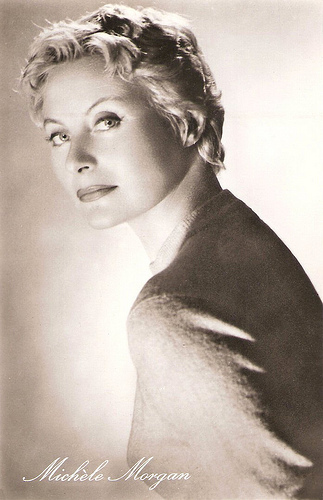
East-German postcard by VEB Progress Film-Vertrieb, Berlin, no. 810. Retail price: 0,20 DM. Publicity still for Les orgueilleux/The Proud Ones (Yves Allégret, Rafael E. Portas, 1953).
No Goodbye Girl
During the 1950s, Michèle Morgan continued to be a major star of the European cinema. She regularly co-starred with her husband, Henri Vidal . Their films together include La belle que voilà/Here Is The Beauty (Jean-Paul Le Chanois, 1950), L'étrange Mme X/The Strange Madame X (Jean Grémillon, 1951), the lavish historical epic Napoléon (Sacha Guitry, 1955) in which she played Josephine, and Pourquoi viens-tu si tard?/Why Do You Come So Late? (Henri Decoin, 1959).
She appeared opposite idol Gérard Philipe in Les Orgueilleux/The Proud Ones (Yves Allégret, 1953) and in the bittersweet Les Grandes Manœuvres/Grand Maneuver(René Clair, 1955). Hal Erickson at AllMovie about the latter: "Phillipe plays a dashing dragoons officer, vintage 1913, who wagers his friends that he can make the next woman who enters the room fall in love with him. In strides drop-dead gorgeous Michele Morgan, and the rest writes itself. Phillipe plans a slow seduction and a quick goodbye; Morgan, need we say, is no 'goodbye girl'."
She starred in the historical film was Marie-Antoinette reine de France/Marie Antoinette Queen of France (Jean Delannoy, 1956). Morgan plays the Austrian princess who becomes the last Queen of France in waning years of the 18th century. She also appeared in the American production The Vintage (Jeffrey Hayden, 1957) with Pier Angeli and Mel Ferrer.
In the remake Menschem im Hotel/Grand Hotel (1959), Morgan played the role of Grusinskaya, which was originally portrayed by Greta Garbo in the award-winning 1932 classic Grand Hotel. Based on a book by Vicki Baum, all of the action takes place in the course of one day in a luxury hotel in Berlin. Grusinkaya is a ballerina staying at the hotel, other guests include a sophisticated thief ( O.W. Fischer ), a dying man ( Heinz Rühmann ), a businessman (Gert Fröbe), and a stenographer ( Sonja Ziemann ). Hal Erickson: "Events intertwine the lives of these strangers, bringing them together for some dramatic moments but not quite as effectively as in the 1932 film."
Henri Vidal suddenly died in 1959. A year later, Morgan married film director and actor/writer Gérard Oury and stayed with him till his death in 2006.
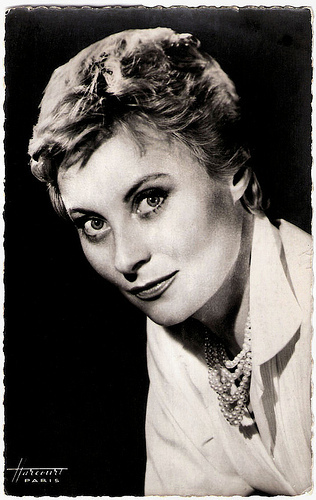
French postcard by Editions du Globe, Paris, no. 579. Photo: Studio Harcourt.
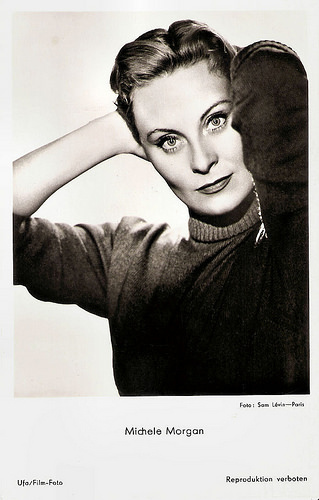
German postcard by Ufa, Berlin-Tempelhof, no. FK 418. Photo: Sam Lévin, Paris.
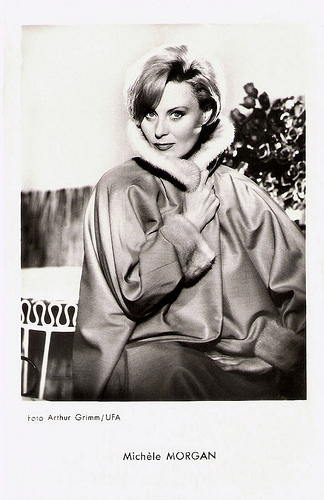
French postcard by Editions P.I., Paris (Licency holder in France for Ufa), no. FK 17A. Offered by Les carbones Korès 'Carboplane'. Photo: Arthur Grimm / Ufa.
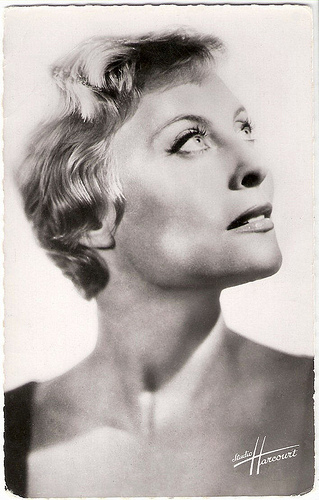
French postcard by Editions du Globe, Paris, no. 283. Photo: Studio Harcourt.
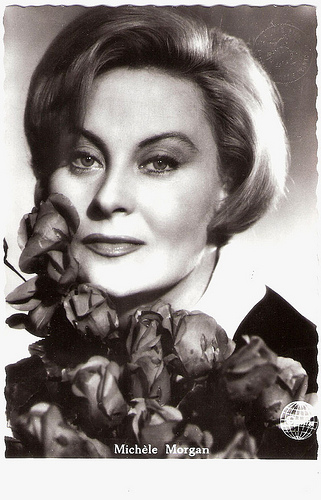
Dutch postcard, no. 960.
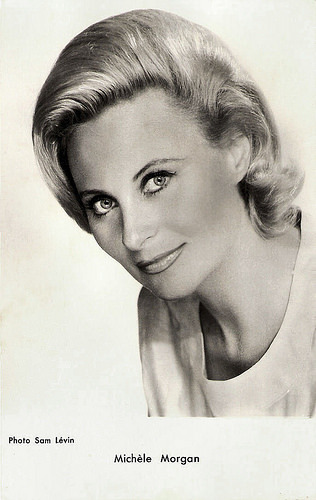
French postcard by Editions P.I., offered by Les Carbones Korès Carboplane, no. 1137. Photo: Sam Lévin.
Cravates Michèle Morgan
Michèle Morgan appeared in three films with her third husband, actor and director Gérard Oury: La belle que voilà/Here Is The Beauty (Jean-Paul Le Chanois, 1950), Le miroir à deux faces/The Mirror has Two Faces (André Cayatte, 1958) and Un homme et une femme, 20 ans déjà/A Man and a Woman: 20 Years Later (Claude Lelouch, 1986). She also worked under his direction in a segment of Le crime ne paie pas/Crime Does Not Pay (Gérard Oury, 1962).
Her career took a downturn when the French Nouvelle Vague (New Wave) movement came along in the late 1950s. Its key directors decided to cut ties with the classic French cinema, which many of them had largely despised since the days they had been serving as critics for the Cahiers du cinéma. The only film she did by a Nouvelle Vague auteur was Claude Chabrol's Landru (1963), about French serial killer Henri-Desire Landru (Charles Denner), who wined, dined, scammed, and dismembered over 10 women during WW I. Morgan played a victim, who's eventually burned down by Landru to go up in smoke.
Throughout the 1960s, Morgan continued working in the international cinema. She appeared in films like the Italian historical drama Il fornaretto di Venezia/The Scapegoat (Duccio Tessari, 1963) with Jacques Perrin , the American war drama Lost Command (Mark Robson, 1966) starring Anthony Quinn, and the French comedy Benjamin (Michel Deville, 1968) with Catherine Deneuve and Pierre Clémenti.
In 1968 she largely retired from the screen, but has occasionally returned in films like Le Chat et la souris/Cat and Mouse (Claude Lelouch, 1975) with Serge Reggiani , and Stanno tutti bene/Everbody's Fine (Giuseppe Tornatore, 1990) with Marcello Mastroianni . About the first, D.B. DuMonteil notes at IMDb : "Lelouch really plays cat and mouse with the audience as Detective Lechat (sic)(Regggiani) does with his still attractive suspect (or is it the other way about?). There are plenty of funny scenes and some witty lines. (...) Objections: there are not enough scenes where Reggiani and Morgan are together".
From the 1970s on, she has concentrated on painting, designing ties and writing poems. As a painter she has had several successful exhibitions in Paris. She established her own tie label Cravates Michèle Morgan in the late 1970s. In 1977 she published her autobiography Avec ces yeux-là (With Those Eyes). In the 1980s and 1990s she also appeared in different TV films and miniseries.
Michèle Morgan was named Chevalier of the Légion d'honneur (Legion of Honor) in 1969, and she was made an Officer of the Ordre national du Mérite (French National Order of Merit) in 1975. Morgan also has a star on the Hollywood Walk of Fame. And in 1992 she was given a Honorary César Award for her long service to the French cinema.
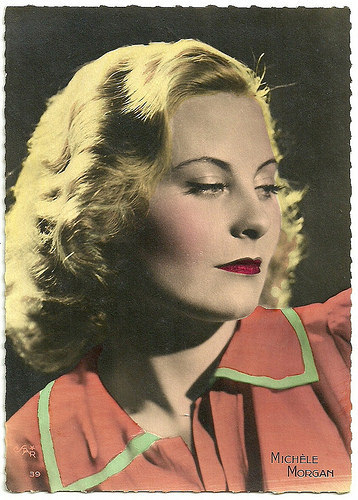
French postcard by Editions P.I., Paris, no. 39. Photo: Star.
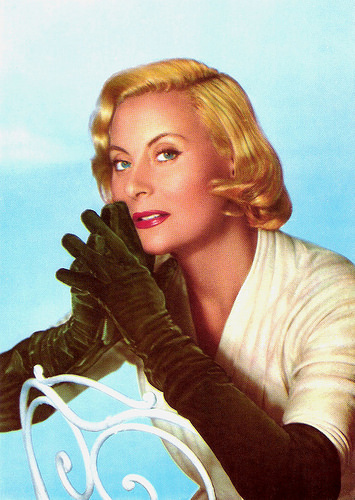
French postcard by Editions P.I., Paris, no. 1009. Photo: Sam Lévin.
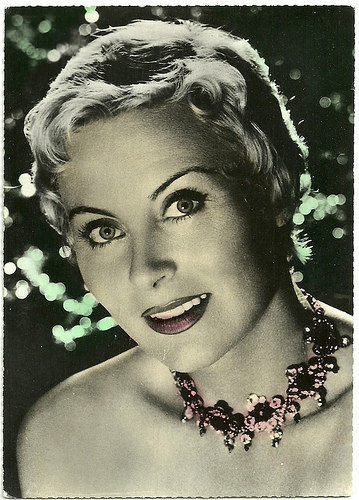
French postcard by Z K, no. 1937.
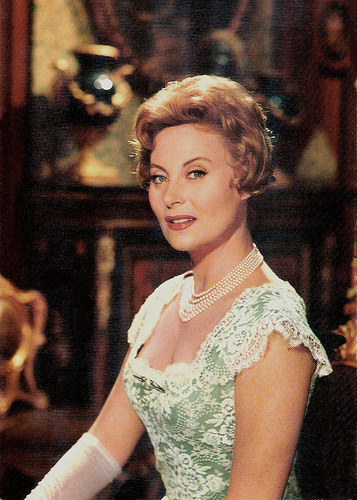
Italian postcard by Rotalcolor, Milano, no. 72.
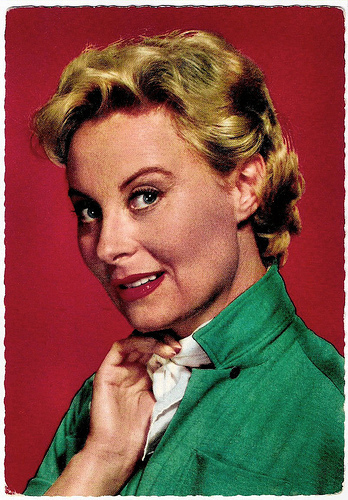
German postcard by ISV, no. B 15. Photo: MGM.
Trailer for Les Orgueilleux/The Proud Ones (Yves Allégret, 1953). Source: Plamen Plamenov (YouTube).
Trailer for The Vintage (1957). Source: Luis Peix (YouTube).
Sources: Hal Erickson (AllMovie), (IMDb), DB DuMonteil (IMDb), Wikipedia, AllMovie, and .

French postcard by Editions P.I., Paris, no. 451. Photo: Sam Lévin.

French postcard by Editions P.I., Paris, no. 184. Photo: Sam Lévin.

French postcard by Editions du Globe (E.D.U.G.), no. 66. Photo: Studio Harcourt.

French postcard by Editions du Globe, Paris, no. 616. Photo: Sam Lévin.

East-German postcard by VEB Progress Film-Vertrieb, Berlin, no. 810. Retail price: 0,20 DM. Publicity still for Les orgueilleux/The Proud Ones (Yves Allégret, Rafael E. Portas, 1953).
No Goodbye Girl
During the 1950s, Michèle Morgan continued to be a major star of the European cinema. She regularly co-starred with her husband, Henri Vidal . Their films together include La belle que voilà/Here Is The Beauty (Jean-Paul Le Chanois, 1950), L'étrange Mme X/The Strange Madame X (Jean Grémillon, 1951), the lavish historical epic Napoléon (Sacha Guitry, 1955) in which she played Josephine, and Pourquoi viens-tu si tard?/Why Do You Come So Late? (Henri Decoin, 1959).
She appeared opposite idol Gérard Philipe in Les Orgueilleux/The Proud Ones (Yves Allégret, 1953) and in the bittersweet Les Grandes Manœuvres/Grand Maneuver(René Clair, 1955). Hal Erickson at AllMovie about the latter: "Phillipe plays a dashing dragoons officer, vintage 1913, who wagers his friends that he can make the next woman who enters the room fall in love with him. In strides drop-dead gorgeous Michele Morgan, and the rest writes itself. Phillipe plans a slow seduction and a quick goodbye; Morgan, need we say, is no 'goodbye girl'."
She starred in the historical film was Marie-Antoinette reine de France/Marie Antoinette Queen of France (Jean Delannoy, 1956). Morgan plays the Austrian princess who becomes the last Queen of France in waning years of the 18th century. She also appeared in the American production The Vintage (Jeffrey Hayden, 1957) with Pier Angeli and Mel Ferrer.
In the remake Menschem im Hotel/Grand Hotel (1959), Morgan played the role of Grusinskaya, which was originally portrayed by Greta Garbo in the award-winning 1932 classic Grand Hotel. Based on a book by Vicki Baum, all of the action takes place in the course of one day in a luxury hotel in Berlin. Grusinkaya is a ballerina staying at the hotel, other guests include a sophisticated thief ( O.W. Fischer ), a dying man ( Heinz Rühmann ), a businessman (Gert Fröbe), and a stenographer ( Sonja Ziemann ). Hal Erickson: "Events intertwine the lives of these strangers, bringing them together for some dramatic moments but not quite as effectively as in the 1932 film."
Henri Vidal suddenly died in 1959. A year later, Morgan married film director and actor/writer Gérard Oury and stayed with him till his death in 2006.

French postcard by Editions du Globe, Paris, no. 579. Photo: Studio Harcourt.

German postcard by Ufa, Berlin-Tempelhof, no. FK 418. Photo: Sam Lévin, Paris.

French postcard by Editions P.I., Paris (Licency holder in France for Ufa), no. FK 17A. Offered by Les carbones Korès 'Carboplane'. Photo: Arthur Grimm / Ufa.

French postcard by Editions du Globe, Paris, no. 283. Photo: Studio Harcourt.

Dutch postcard, no. 960.

French postcard by Editions P.I., offered by Les Carbones Korès Carboplane, no. 1137. Photo: Sam Lévin.
Cravates Michèle Morgan
Michèle Morgan appeared in three films with her third husband, actor and director Gérard Oury: La belle que voilà/Here Is The Beauty (Jean-Paul Le Chanois, 1950), Le miroir à deux faces/The Mirror has Two Faces (André Cayatte, 1958) and Un homme et une femme, 20 ans déjà/A Man and a Woman: 20 Years Later (Claude Lelouch, 1986). She also worked under his direction in a segment of Le crime ne paie pas/Crime Does Not Pay (Gérard Oury, 1962).
Her career took a downturn when the French Nouvelle Vague (New Wave) movement came along in the late 1950s. Its key directors decided to cut ties with the classic French cinema, which many of them had largely despised since the days they had been serving as critics for the Cahiers du cinéma. The only film she did by a Nouvelle Vague auteur was Claude Chabrol's Landru (1963), about French serial killer Henri-Desire Landru (Charles Denner), who wined, dined, scammed, and dismembered over 10 women during WW I. Morgan played a victim, who's eventually burned down by Landru to go up in smoke.
Throughout the 1960s, Morgan continued working in the international cinema. She appeared in films like the Italian historical drama Il fornaretto di Venezia/The Scapegoat (Duccio Tessari, 1963) with Jacques Perrin , the American war drama Lost Command (Mark Robson, 1966) starring Anthony Quinn, and the French comedy Benjamin (Michel Deville, 1968) with Catherine Deneuve and Pierre Clémenti.
In 1968 she largely retired from the screen, but has occasionally returned in films like Le Chat et la souris/Cat and Mouse (Claude Lelouch, 1975) with Serge Reggiani , and Stanno tutti bene/Everbody's Fine (Giuseppe Tornatore, 1990) with Marcello Mastroianni . About the first, D.B. DuMonteil notes at IMDb : "Lelouch really plays cat and mouse with the audience as Detective Lechat (sic)(Regggiani) does with his still attractive suspect (or is it the other way about?). There are plenty of funny scenes and some witty lines. (...) Objections: there are not enough scenes where Reggiani and Morgan are together".
From the 1970s on, she has concentrated on painting, designing ties and writing poems. As a painter she has had several successful exhibitions in Paris. She established her own tie label Cravates Michèle Morgan in the late 1970s. In 1977 she published her autobiography Avec ces yeux-là (With Those Eyes). In the 1980s and 1990s she also appeared in different TV films and miniseries.
Michèle Morgan was named Chevalier of the Légion d'honneur (Legion of Honor) in 1969, and she was made an Officer of the Ordre national du Mérite (French National Order of Merit) in 1975. Morgan also has a star on the Hollywood Walk of Fame. And in 1992 she was given a Honorary César Award for her long service to the French cinema.

French postcard by Editions P.I., Paris, no. 39. Photo: Star.

French postcard by Editions P.I., Paris, no. 1009. Photo: Sam Lévin.

French postcard by Z K, no. 1937.

Italian postcard by Rotalcolor, Milano, no. 72.

German postcard by ISV, no. B 15. Photo: MGM.
Trailer for Les Orgueilleux/The Proud Ones (Yves Allégret, 1953). Source: Plamen Plamenov (YouTube).
Trailer for The Vintage (1957). Source: Luis Peix (YouTube).
Sources: Hal Erickson (AllMovie), (IMDb), DB DuMonteil (IMDb), Wikipedia, AllMovie, and .
Published on December 28, 2015 22:00
December 27, 2015
Michèle Morgan, Part 1
Blond actress Michèle Morgan (1920) was a classic beauty, specially noted for her feline, expressive eyes. She has been one of the most popular leading ladies of the French cinema for over five decades. Today EFSP focuses on the first part of her career, including her years in Hollywood. Tomorrow follows part two.
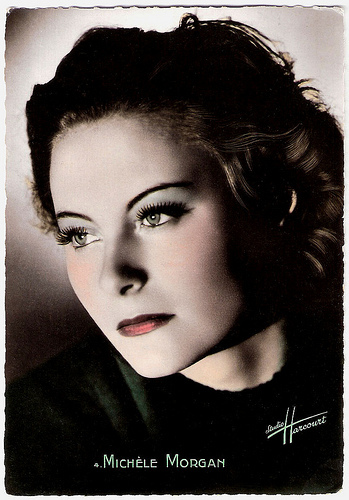
French postcard by Greff S.E.R.P. Editeur, Paris, no. 4. Photo: Studio Harcourt.
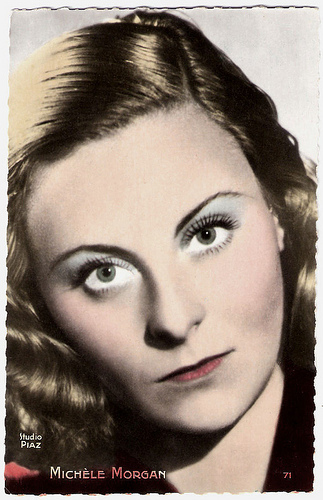
French postcard by Editions P.I., no. 71. Photo: Studio Piaz.
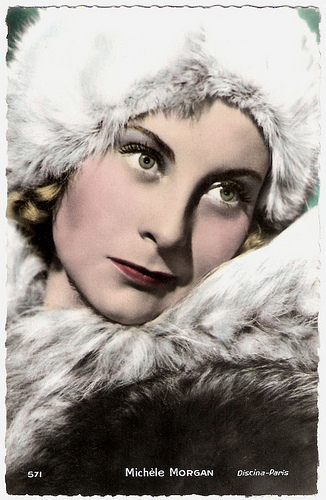
French postcard by Edit. Chantal, Rueil, no. 571. Photo: Discina, Paris.
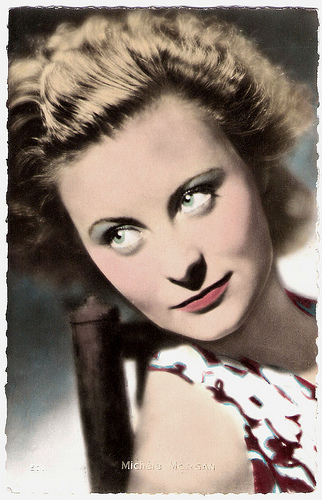
French postcard by Edit. Chantal, Rueil, no. 571 (?).
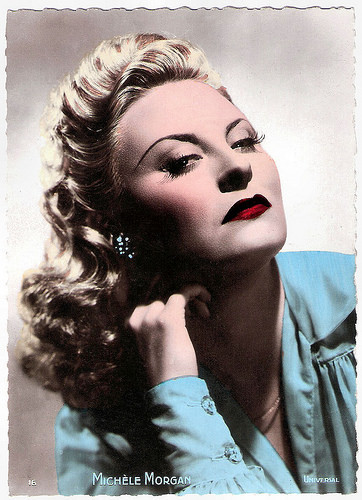
French postcard by Editions P.I., Paris, no. 16. Photo: Universal.
Gloomy Allure
Michèle Morgan was born as Simone Renée Roussel in 1920, in Neuilly-sur-Seine, France. Michèle has three younger brothers. Her father was a departmental head in an export house of fragrances. After the crisis of 1929, he found himself unemployed and relocated the family from the wealthy Parisian suburb of Neuilly-sur-Seine to Dieppe in Upper Normandy.
It was at the Dieppe Casino that Michèle began to attend stage shows and became enamoured with the idea of acting. At 15, she left home with her younger brother Paul to pursue an acting career in Paris. There, she began her career working as an extra. Through a casting agency, she won a bit role in Mademoiselle Mozart/Meet Miss Mozart (Yvan Noé, 1935) starring Danielle Darrieux .
The film's director, Yvan Noé, suggested her to perfect her acting technique by taking lessons. With her salaries for small roles in films like Une fille à papa/A Daughter for Father (René Guissart, 1935) with Josette Day , she paid for drama classes. Morgan studied acting under René Simon and chose the pseudonym of Michèle Morgan, taking it from the Morgan Bank in Paris.
She was soon noticed by director Marc Allégret who offered her a major role in the comedy Gribouille (1937), opposite the great French actor Raimu . Then came Orage (Marc Allégret, 1938) with Charles Boyer , the classic romantic crime drama Le Quai des brumes/Port of Shadows (Marcel Carné, 1938) opposite Jean Gabin and Michel Simon , and Remorques (Jean Grémillon, 1941) again opposite Jean Gabin .
These films established Michèle Morgan as one of the leading actress of the time in French cinema. Gary Brumburgh at IMDb : "Her remote, enigmatic features and gloomy allure had audiences comparing her to a young Greta Garbo ."
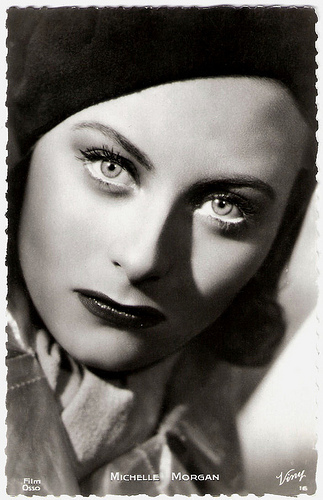
French postcard by Viny, no. 16. Photo: Film Osso. Publicity still for Marcel Carné's classic film Quai des brûmes/Port of Shadows (1938).
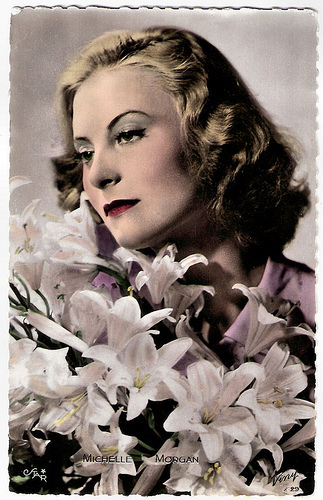
French postcard by Viny, no. 29. Photo: Star.
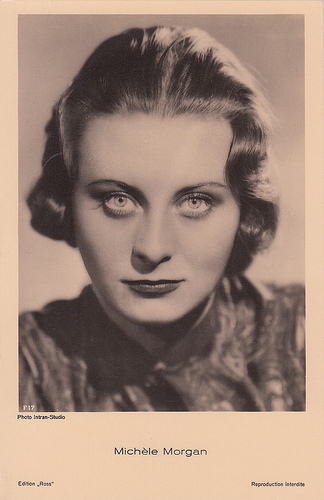
French postcard by Edition Ross, no. F17. Photo: Intran-Studio. Collection: Marlène Pilaete.
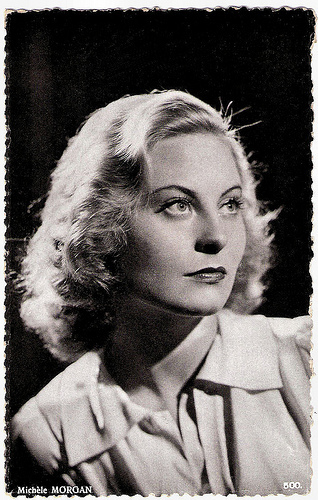
French postcard by C.M.B., no. 500.
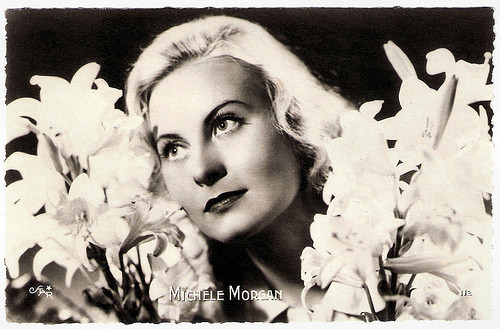
French postcard by Editions O.P., Paris, no. 112. Photo: Star.
So-so Reception in the USA
Upon the invasion of France in 1940 by the Germans, Michèle Morgan left for the United States. However, she had already been offered her contract with RKO before the start of WW2. She married American actor/singer William Marshall in 1942. Their son Mike Marshall (1944-2005) later became an actor in both France and Hollywood.
Morgan started to work for RKO. She was considered for the role of Lina in Alfred Hitchcock's Suspicion (1941), but was soon passed over since her English wasn't deemed good enough. The role went to Joan Fontaine, who won the Best Actress Oscar for her performance. Morgan then worked hard to perfect her English and, for an entire year, she saw a linguistic coach for several hours a day and improved considerably.
Morgan's first Hollywood film became Joan of Paris (Robert Stevenson, 1942), co-starring RKO leading man Paul Henreid. It would be her only American hit. Her Hollywood adventure proved to be disappointing. Gary Brumburgh at IMDb : "Her eventual move to Hollywood was based purely on her European prestige, but she did not stand out among the other female foreign imports of that time, such as Ingrid Bergman ."
Nothing major came her way apart from rather routine sultry roles amid WW II surroundings. A disaster was her part in the musical Higher and Higher (Tim Whelan, 1943) starring Jack Haley and Frank Sinatra. Morgan had no prior singing experience and was supposed to take a few lessons as quickly as possible.
Morgan was considered for the role of Ilsa Lund in Casablanca (Michael Curtiz, 1942), but her studio RKO wouldn't release her for the amount of money Warner Bros was offering and Ingrid Bergman was cast instead. Later, she did make Passage to Marseille (Michael Curtiz, 1944)with director Michael Curtiz and Humphrey Bogart. But this film was far less successful than Casablanca. Her last American film was the noirish The Chase (Arthur Ripley, 1946) based on a novel by Cornell Woolrich and starring Robert Cummings.
After the so-so reception for her American films, Michèle Morgan returned to France. In her autobiography Avec ces yeux-là (With Those Eyes, 1977), she tells an ominous anecdote about her house in Hollywood. She had a house built at 10050 Cielo Drive, slightly isolated from the other star mansions. Michèle was scared at the thought of staying alone at the place and claimed that she was often hearing sinister noises. She decided to move in with her new husband, William Marshall. In 1969, the house became site of Sharon Tate's murder by the followers of Charles Manson.
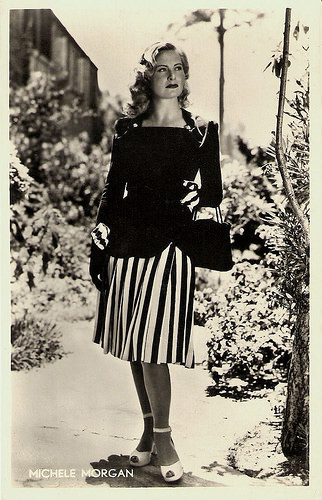
Dutch postcard by S. & v. H. A. Photo: M.P.E.A.
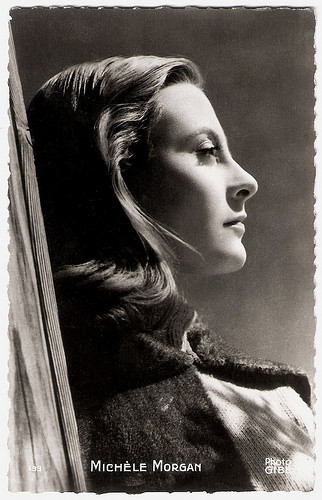
French postcard by Editions P.I., La Garenne-Colombes, no. 133. Photo: GIBE.
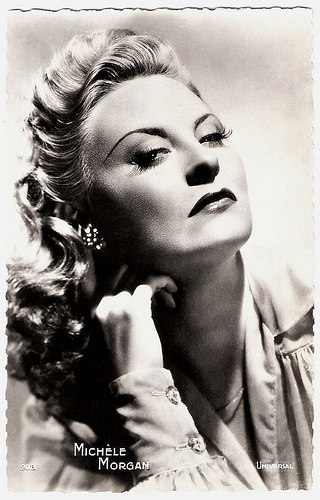
French postcard by Editions P.I., Paris, no. 208. Photo: Universal.
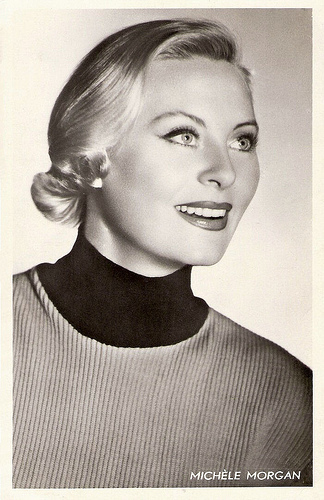
Dutch postcard by Takken, Utrecht, no. AX 1939.
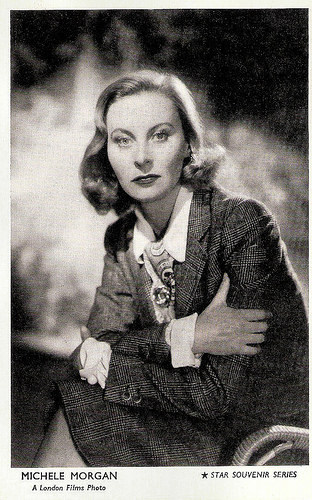
British postcard in the Star Souvenir Series by Jarrold and Sons, Ltd, Norwich, no. 61. Photo: London Films. Publicity still for Maria Chapdelaine (Marc Allégret, 1950).
With Those Eyes
At home in France, Michèle Morgan was treated much better than in Hollywood. She received the Best Actress award at the Cannes Film Festival for her touching performance as the blind heroine in La symphonie pastorale (Jean Delannoy, 1946) with Pierre Blanchar . She then appeared in the British thriller The Fallen Idol (Carol Reed, 1948) opposite Ralph Richardson .
Next, she moved to Italy for Fabiola (Alessandro Blasetti, 1949). After several years of wartime austerity, the Italian film industry returned to the Peplum, the sand and sandals spectacle. Morgan plays the title role, the daughter of a Roman aristocrat ( Michel Simon ) during the takeover by Emperor Constantine. As a reaction to Constantine's Christian conversion policy, many old-line Romans are persecuting the city's Christian community, killing the believers off before Constantine marches into town. Fabiola is loyal to her Christian-sympathizing father but is irresistibly drawn to a Roman gladiator ( Henri Vidal ).
Privately she was also drawn to Vidal. During the shooting of the film, she secretly began a relationship with her co-star. At the time her marriage to William Marshall was already falling to pieces. Mike Marshall, who wished to gain custody of their son, hired some private detectives to follow Morgan's moves and eventually managed to have her photographed in bed with Henri Vidal . Morgan therefore lost custody of Mike due to adultery. In 1950 Vidal and Morgan married.
In 1950 she also appeared in Maria Chapdelaine/The Naked Heart (Marc Allegret, 1950). Adapter and director Allegret has fashioned the novel by Louis Hemon into a vehicle for his successful discovery. Morgan plays a young woman whose romantic fantasies begin spilling over into actuality. The film's novelty value is its setting: a remote village in Northern Canada. Filmed simultaneously in French and English-language versions, The Naked Heart was produced independently on a tiny budget. Hal Erickson at AllMovie : "while the seams begin to show towards the end, for the most part the film works."
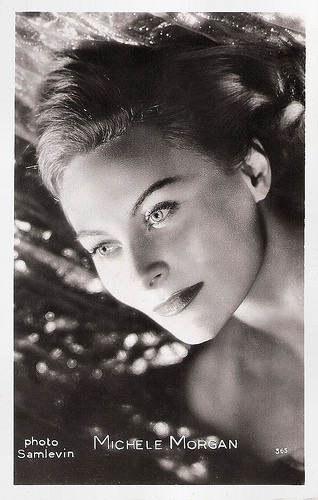
French postcard by Editions P.I., Paris, no. 365. Photo: Sam Lévin, Paris.
DVD trailer for Le Quai des brumes/Port of Shadows (1938). Source: Criterion Dungeon (YouTube).
Scene from Remorques (1941). Source: Carochoupi (YouTube).
Trailer for Joan of Paris (Robert Stevenson, 1942). Source: Captain bijou (YouTube).
To be continued tomorrow.
Sources: (IMDb), Hal Erickson (AllMovie), Wikipedia, AllMovie, and .

French postcard by Greff S.E.R.P. Editeur, Paris, no. 4. Photo: Studio Harcourt.

French postcard by Editions P.I., no. 71. Photo: Studio Piaz.

French postcard by Edit. Chantal, Rueil, no. 571. Photo: Discina, Paris.

French postcard by Edit. Chantal, Rueil, no. 571 (?).

French postcard by Editions P.I., Paris, no. 16. Photo: Universal.
Gloomy Allure
Michèle Morgan was born as Simone Renée Roussel in 1920, in Neuilly-sur-Seine, France. Michèle has three younger brothers. Her father was a departmental head in an export house of fragrances. After the crisis of 1929, he found himself unemployed and relocated the family from the wealthy Parisian suburb of Neuilly-sur-Seine to Dieppe in Upper Normandy.
It was at the Dieppe Casino that Michèle began to attend stage shows and became enamoured with the idea of acting. At 15, she left home with her younger brother Paul to pursue an acting career in Paris. There, she began her career working as an extra. Through a casting agency, she won a bit role in Mademoiselle Mozart/Meet Miss Mozart (Yvan Noé, 1935) starring Danielle Darrieux .
The film's director, Yvan Noé, suggested her to perfect her acting technique by taking lessons. With her salaries for small roles in films like Une fille à papa/A Daughter for Father (René Guissart, 1935) with Josette Day , she paid for drama classes. Morgan studied acting under René Simon and chose the pseudonym of Michèle Morgan, taking it from the Morgan Bank in Paris.
She was soon noticed by director Marc Allégret who offered her a major role in the comedy Gribouille (1937), opposite the great French actor Raimu . Then came Orage (Marc Allégret, 1938) with Charles Boyer , the classic romantic crime drama Le Quai des brumes/Port of Shadows (Marcel Carné, 1938) opposite Jean Gabin and Michel Simon , and Remorques (Jean Grémillon, 1941) again opposite Jean Gabin .
These films established Michèle Morgan as one of the leading actress of the time in French cinema. Gary Brumburgh at IMDb : "Her remote, enigmatic features and gloomy allure had audiences comparing her to a young Greta Garbo ."

French postcard by Viny, no. 16. Photo: Film Osso. Publicity still for Marcel Carné's classic film Quai des brûmes/Port of Shadows (1938).

French postcard by Viny, no. 29. Photo: Star.

French postcard by Edition Ross, no. F17. Photo: Intran-Studio. Collection: Marlène Pilaete.

French postcard by C.M.B., no. 500.

French postcard by Editions O.P., Paris, no. 112. Photo: Star.
So-so Reception in the USA
Upon the invasion of France in 1940 by the Germans, Michèle Morgan left for the United States. However, she had already been offered her contract with RKO before the start of WW2. She married American actor/singer William Marshall in 1942. Their son Mike Marshall (1944-2005) later became an actor in both France and Hollywood.
Morgan started to work for RKO. She was considered for the role of Lina in Alfred Hitchcock's Suspicion (1941), but was soon passed over since her English wasn't deemed good enough. The role went to Joan Fontaine, who won the Best Actress Oscar for her performance. Morgan then worked hard to perfect her English and, for an entire year, she saw a linguistic coach for several hours a day and improved considerably.
Morgan's first Hollywood film became Joan of Paris (Robert Stevenson, 1942), co-starring RKO leading man Paul Henreid. It would be her only American hit. Her Hollywood adventure proved to be disappointing. Gary Brumburgh at IMDb : "Her eventual move to Hollywood was based purely on her European prestige, but she did not stand out among the other female foreign imports of that time, such as Ingrid Bergman ."
Nothing major came her way apart from rather routine sultry roles amid WW II surroundings. A disaster was her part in the musical Higher and Higher (Tim Whelan, 1943) starring Jack Haley and Frank Sinatra. Morgan had no prior singing experience and was supposed to take a few lessons as quickly as possible.
Morgan was considered for the role of Ilsa Lund in Casablanca (Michael Curtiz, 1942), but her studio RKO wouldn't release her for the amount of money Warner Bros was offering and Ingrid Bergman was cast instead. Later, she did make Passage to Marseille (Michael Curtiz, 1944)with director Michael Curtiz and Humphrey Bogart. But this film was far less successful than Casablanca. Her last American film was the noirish The Chase (Arthur Ripley, 1946) based on a novel by Cornell Woolrich and starring Robert Cummings.
After the so-so reception for her American films, Michèle Morgan returned to France. In her autobiography Avec ces yeux-là (With Those Eyes, 1977), she tells an ominous anecdote about her house in Hollywood. She had a house built at 10050 Cielo Drive, slightly isolated from the other star mansions. Michèle was scared at the thought of staying alone at the place and claimed that she was often hearing sinister noises. She decided to move in with her new husband, William Marshall. In 1969, the house became site of Sharon Tate's murder by the followers of Charles Manson.

Dutch postcard by S. & v. H. A. Photo: M.P.E.A.

French postcard by Editions P.I., La Garenne-Colombes, no. 133. Photo: GIBE.

French postcard by Editions P.I., Paris, no. 208. Photo: Universal.

Dutch postcard by Takken, Utrecht, no. AX 1939.

British postcard in the Star Souvenir Series by Jarrold and Sons, Ltd, Norwich, no. 61. Photo: London Films. Publicity still for Maria Chapdelaine (Marc Allégret, 1950).
With Those Eyes
At home in France, Michèle Morgan was treated much better than in Hollywood. She received the Best Actress award at the Cannes Film Festival for her touching performance as the blind heroine in La symphonie pastorale (Jean Delannoy, 1946) with Pierre Blanchar . She then appeared in the British thriller The Fallen Idol (Carol Reed, 1948) opposite Ralph Richardson .
Next, she moved to Italy for Fabiola (Alessandro Blasetti, 1949). After several years of wartime austerity, the Italian film industry returned to the Peplum, the sand and sandals spectacle. Morgan plays the title role, the daughter of a Roman aristocrat ( Michel Simon ) during the takeover by Emperor Constantine. As a reaction to Constantine's Christian conversion policy, many old-line Romans are persecuting the city's Christian community, killing the believers off before Constantine marches into town. Fabiola is loyal to her Christian-sympathizing father but is irresistibly drawn to a Roman gladiator ( Henri Vidal ).
Privately she was also drawn to Vidal. During the shooting of the film, she secretly began a relationship with her co-star. At the time her marriage to William Marshall was already falling to pieces. Mike Marshall, who wished to gain custody of their son, hired some private detectives to follow Morgan's moves and eventually managed to have her photographed in bed with Henri Vidal . Morgan therefore lost custody of Mike due to adultery. In 1950 Vidal and Morgan married.
In 1950 she also appeared in Maria Chapdelaine/The Naked Heart (Marc Allegret, 1950). Adapter and director Allegret has fashioned the novel by Louis Hemon into a vehicle for his successful discovery. Morgan plays a young woman whose romantic fantasies begin spilling over into actuality. The film's novelty value is its setting: a remote village in Northern Canada. Filmed simultaneously in French and English-language versions, The Naked Heart was produced independently on a tiny budget. Hal Erickson at AllMovie : "while the seams begin to show towards the end, for the most part the film works."

French postcard by Editions P.I., Paris, no. 365. Photo: Sam Lévin, Paris.
DVD trailer for Le Quai des brumes/Port of Shadows (1938). Source: Criterion Dungeon (YouTube).
Scene from Remorques (1941). Source: Carochoupi (YouTube).
Trailer for Joan of Paris (Robert Stevenson, 1942). Source: Captain bijou (YouTube).
To be continued tomorrow.
Sources: (IMDb), Hal Erickson (AllMovie), Wikipedia, AllMovie, and .
Published on December 27, 2015 22:00
December 26, 2015
Emmi Kosáry
Emmi Kosáry (1889-1964) was a Hungarian opera diva and operetta prima donna with a beautiful soprano voice. She also became a film actress, who worked in Hungary with the young Michael Curtiz. Kosáry was the wife of composer Ákos Buttykay.
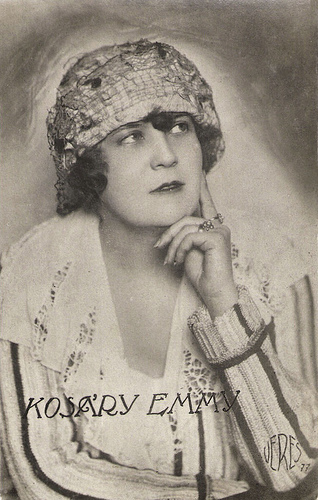
Hungarian postcard by Veres, no. 77.
The Gypsy Princess
Emmi (or Emmy) Kosáry was born Kosári Emma Kornélia in Kisszeben (Sabikov), Hungary, in 1889. She was the daughter of Emil and Emma Kosáry.
After graduating from secondary school, she studied for pianist and opera singer. In 1908 she began her career at the Király Színház (King's Theatre). In 1909 she married composer Ákos Buttykay.
In 1912, she was engaged by the Operaház, the Budapest Opera House. Here she worked as a coloratura singer until 1915. In 1916, she performed for the first times one of her most beloved roles, the lead role in the operetta Die Csárdásfürstin (The Gypsy Princess) by Hungarian composer Emmerich Kálmán, with a libretto by Leo Stein and Bela Jenbach.
In 1916 Emmi Kosáry returned to the Király Színház, where he played until 1919. From 1916 till 1921 she starred at the Vígszínházban (Comedy Theatre) and in 1920 she played as a guest at the Városi Színházban (Municipal Theatre).
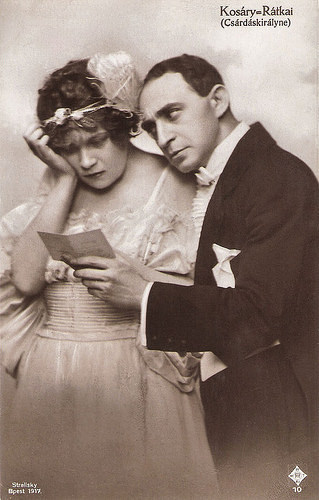
Hungarian postcard by Magyar Rotophot Tarsáság, Budapest, no. 10. Photo: Strelisky, 1917. Publicity still for the stage play Csárdáskirálynö/The Gypsy Princess (1916).
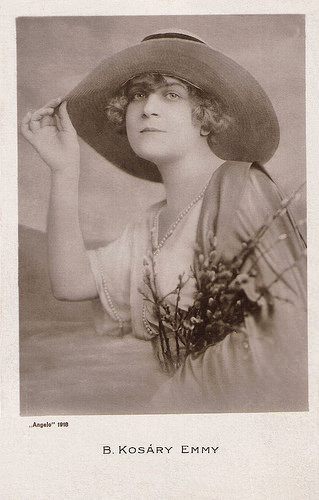
Hungarian postcard by Kiadja Reinitz Jòzsef, Budapest. Photo: Angelo, 1918.
Directed by Michael Curtiz
In 1917, Emmi Kosáry made her film debut in the silent film Tatárjárás/Tartar Invasion (1917) with Camilla von Hollay . The film was directed by Mihály Kertész who later became famous as Hollywood director Michael Curtiz.
Kosáry also performed internationally at the Berlin Opera House and the Vienna Opera House and the Carltheater in Vienna. Later Kosary worked in Hungary at the Budapest Operetta Theatre, the Andrassy Street Theatre and the Bethlen Square Theatre.
Abroad, she performed in cities like Vienna and Dresden. She also performed on stage in the United States in 1923 and 1929.
During the 1930s, she starred in two Hungarian films, the comedy Az okos mama/The Wise Mother (Emil Martonffi, 1935) and Varjú a toronyórán/Crow on the Tower (Endre Rodríguez, 1938).
In 1964, Emmi Kosáry passed away in Budapest, Hungary. She was 75. Her daughter, Emmi Buttykay, who also worked as a film actress, had died in 1957.
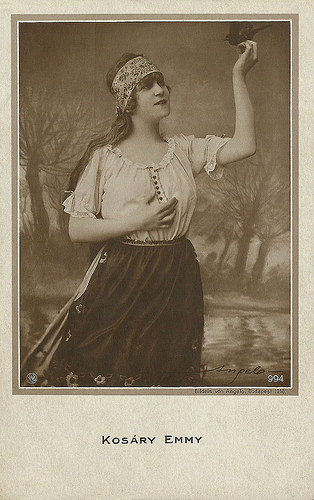
German postcard by NPG, no. 994. Photo: Angelo, Budapest, 1918. Collection: Didier Hanson.
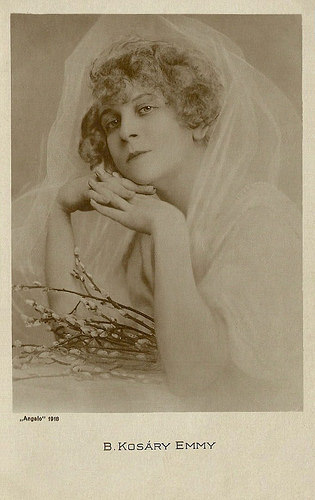
Hungarian postcard. Photo: Angelo. Collection: Didier Hanson.
Sources: Shinhaz.hu (Hungarian), Wikipedia (Hungarian) and .

Hungarian postcard by Veres, no. 77.
The Gypsy Princess
Emmi (or Emmy) Kosáry was born Kosári Emma Kornélia in Kisszeben (Sabikov), Hungary, in 1889. She was the daughter of Emil and Emma Kosáry.
After graduating from secondary school, she studied for pianist and opera singer. In 1908 she began her career at the Király Színház (King's Theatre). In 1909 she married composer Ákos Buttykay.
In 1912, she was engaged by the Operaház, the Budapest Opera House. Here she worked as a coloratura singer until 1915. In 1916, she performed for the first times one of her most beloved roles, the lead role in the operetta Die Csárdásfürstin (The Gypsy Princess) by Hungarian composer Emmerich Kálmán, with a libretto by Leo Stein and Bela Jenbach.
In 1916 Emmi Kosáry returned to the Király Színház, where he played until 1919. From 1916 till 1921 she starred at the Vígszínházban (Comedy Theatre) and in 1920 she played as a guest at the Városi Színházban (Municipal Theatre).

Hungarian postcard by Magyar Rotophot Tarsáság, Budapest, no. 10. Photo: Strelisky, 1917. Publicity still for the stage play Csárdáskirálynö/The Gypsy Princess (1916).

Hungarian postcard by Kiadja Reinitz Jòzsef, Budapest. Photo: Angelo, 1918.
Directed by Michael Curtiz
In 1917, Emmi Kosáry made her film debut in the silent film Tatárjárás/Tartar Invasion (1917) with Camilla von Hollay . The film was directed by Mihály Kertész who later became famous as Hollywood director Michael Curtiz.
Kosáry also performed internationally at the Berlin Opera House and the Vienna Opera House and the Carltheater in Vienna. Later Kosary worked in Hungary at the Budapest Operetta Theatre, the Andrassy Street Theatre and the Bethlen Square Theatre.
Abroad, she performed in cities like Vienna and Dresden. She also performed on stage in the United States in 1923 and 1929.
During the 1930s, she starred in two Hungarian films, the comedy Az okos mama/The Wise Mother (Emil Martonffi, 1935) and Varjú a toronyórán/Crow on the Tower (Endre Rodríguez, 1938).
In 1964, Emmi Kosáry passed away in Budapest, Hungary. She was 75. Her daughter, Emmi Buttykay, who also worked as a film actress, had died in 1957.

German postcard by NPG, no. 994. Photo: Angelo, Budapest, 1918. Collection: Didier Hanson.

Hungarian postcard. Photo: Angelo. Collection: Didier Hanson.
Sources: Shinhaz.hu (Hungarian), Wikipedia (Hungarian) and .
Published on December 26, 2015 22:00
December 25, 2015
Maurizio Arena
Italian film actor Maurizio Arena (1933-1979) appeared in 78 films between 1952 and 1978. In the late 1950s, he became popular as the poor but handsome Roman working class boy in a comedy trilogy by Dino Risi.
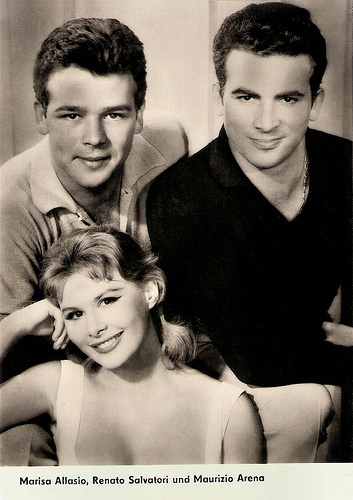
East-German postcard by VEB Progress Film-Vertrieb, Berlin, no. 1356, 1961. Retail price: 0,20 DM. Photo: Progress. Publicity still for Poveri ma belli/Poor But Beautiful (Dino Risi, 1957) with Renato Salvatori (left) and Marisa Allasio .
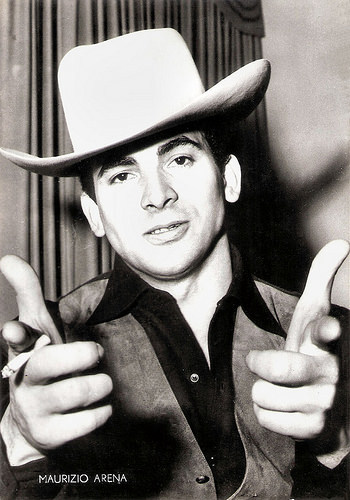
Italian postcard, no. 463.
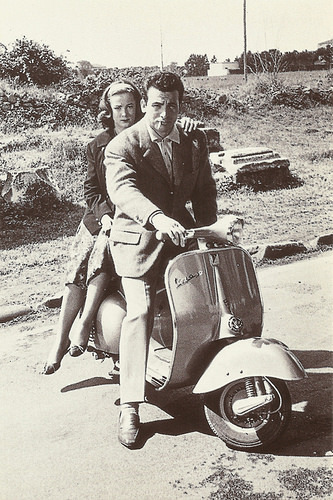
Italian postcard by Ed. Pontedera for Piaggio. Reprint. Maurizio Arena and Cathia Caro on a Vespa, c. 1960. Caro and Rena played together in e.g. Simpatico mascalzone (Mario Amendola, 1959), and Il principe fusto (1960), directed by Arena himself.
Beauties on a Motor Scooter
Maurizio Arena was born as Maurizio di Lorenzo in Rome in 1933.
Arena made his film debut at nineteen years old, with a small role in Bellezze in moto-scooter/Beauties on a motor scooter (Carlo Campogalliani, 1952) featuring Isa Barzizza.
He played Giovanna Ralli ’s boyfriend in Villa Borghese/It Happened in the Park (Vittorio de Sica, Gianni Franciolini, 1953). The film consists of six vignettes set in the Villa Borghese gardens in Rome. He also had a small part in the drama La lupa/She-Wolf (Alberto Lattuada, 1953). It is based on the novella with the same name by Giovanni Verga.
He also played a smart part in the comedy Il segno di Venere/The Sign of Venus (Dino Risi, 1955) starring Sophia Loren , which was entered into the 1955 Cannes Film Festival. He had a bigger role as a thief in the Totò comedy Totò e Carolina/Totò and Carolina (Mario Monicelli,1955) with Anna-Maria Ferrero . The film was banned when it was first released, as it made fun of a policeman.
His breakout role came in 1956 with the role of Romolo in the successful romance-comedy film Poveri ma belli/Poor, But Handsome (Dino Risi, 1956). Romolo and Salvatore ( Renato Salvatori ) are two poor, but handsome friends, who live with their parents in Piazza Navona, Rome, and who both fall in love with Giovanna ( Marisa Allasio ). The success of the film lead to two sequels with Arena and Salvatori, Belle ma povere/Pretty But Poor (Dino Risi, 1957) and Poveri milionari/Poor Millionaires (Dino Risi, 1958).
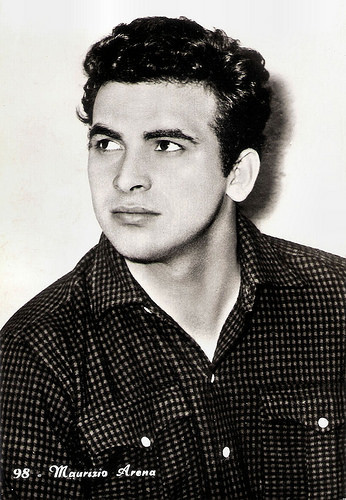
Italian postcard by Turismofoto, no. 98.
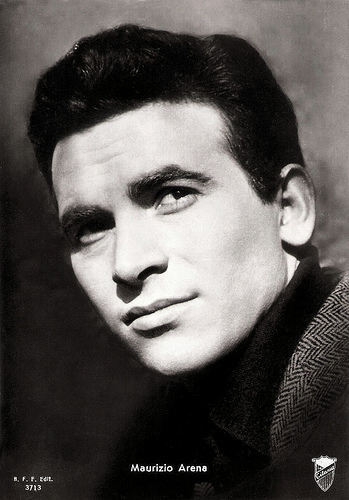
Italian postcard by Casa Editr. Ballerini & Fratini, Firenze, no. 3713. Photo: G.B. Poletto / Titanus. Publicity still for Poveri milionari/Poor Millionaires (Dino Risi, 1958).
Telefoni bianchi
Until the early 1960s, Maurizio Arena was one of the most popular actors in the Italian cinema. He appeared in such films as the adventure Il diavolo nero/The Black Devil (Sergio Grieco, 1957), the comedy Amore e guai/Love and Troubles (Angelo Dorigo, 1958) starring Marcello Mastroianni , and the drama Un uomo facile/The Defeated Victor (Paolo Heusch, 1958).
He was also a protagonist of the gossip columns for his tumultuous love life. During the 1960s, his film career went into decline. His films included the comedy Il carabiniere a cavallo/The policeman on horseback (Carlo Lizzani, 1962) starring Nino Manfredi , the drama La fuga/The Escape (Paolo Spinola, 1964) starring Giovanna Ralli , and the anthology comedy Le bambole/The Dolls (Luigi Comencini a.o., 1965).
In the following decade, he kept active as a character actor in often mediocre films. More or less interesting were the heist film Las Vegas 500 Milliones/They Came to Rob Las Vegas (Antonio Isasi-Isasmendi, 1968), starring Gary Lockwood and Elke Sommer , and the historical drama Il delitto Matteotti/The Assassination of Matteotti (Florestano Vancini, 1973), starring Mario Adorf and Franco Nero .
Arena reunited with director Dino Risi for one of his final films, the excellent comedy Telefoni bianchi/The Diary of a Chambermaid (Dino Risi, 1976) with Agostina Belli. This was an homage to Italy’s White Telephone films, the sophisticated comedy-dramas of the 1930s and 1940s, revolving around working-class girls.
In the last years of his short life Arena was also a healer with some local following, and he was an occasional singer. In 1979, Maurizio Arena died in Rome at the age of 45, following a heart attack. In 2008 a park was named after him in his native district Garbatella.
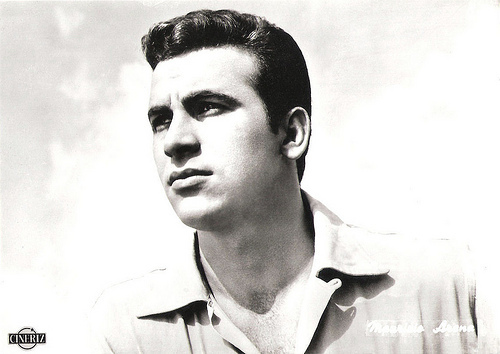
Italian postcard by Bromofoto, no. 1439. Photo: Cineriz.
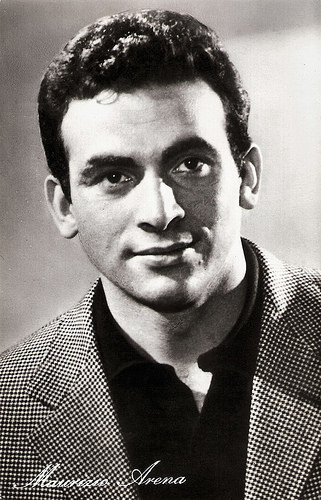
East-German postcard by VEB Progress Film-Vertrieb, Berlin, no. 1352, 1960. Retail price: 0,20 DM. Photo: Progress.
Sources: Wikipedia and .

East-German postcard by VEB Progress Film-Vertrieb, Berlin, no. 1356, 1961. Retail price: 0,20 DM. Photo: Progress. Publicity still for Poveri ma belli/Poor But Beautiful (Dino Risi, 1957) with Renato Salvatori (left) and Marisa Allasio .

Italian postcard, no. 463.

Italian postcard by Ed. Pontedera for Piaggio. Reprint. Maurizio Arena and Cathia Caro on a Vespa, c. 1960. Caro and Rena played together in e.g. Simpatico mascalzone (Mario Amendola, 1959), and Il principe fusto (1960), directed by Arena himself.
Beauties on a Motor Scooter
Maurizio Arena was born as Maurizio di Lorenzo in Rome in 1933.
Arena made his film debut at nineteen years old, with a small role in Bellezze in moto-scooter/Beauties on a motor scooter (Carlo Campogalliani, 1952) featuring Isa Barzizza.
He played Giovanna Ralli ’s boyfriend in Villa Borghese/It Happened in the Park (Vittorio de Sica, Gianni Franciolini, 1953). The film consists of six vignettes set in the Villa Borghese gardens in Rome. He also had a small part in the drama La lupa/She-Wolf (Alberto Lattuada, 1953). It is based on the novella with the same name by Giovanni Verga.
He also played a smart part in the comedy Il segno di Venere/The Sign of Venus (Dino Risi, 1955) starring Sophia Loren , which was entered into the 1955 Cannes Film Festival. He had a bigger role as a thief in the Totò comedy Totò e Carolina/Totò and Carolina (Mario Monicelli,1955) with Anna-Maria Ferrero . The film was banned when it was first released, as it made fun of a policeman.
His breakout role came in 1956 with the role of Romolo in the successful romance-comedy film Poveri ma belli/Poor, But Handsome (Dino Risi, 1956). Romolo and Salvatore ( Renato Salvatori ) are two poor, but handsome friends, who live with their parents in Piazza Navona, Rome, and who both fall in love with Giovanna ( Marisa Allasio ). The success of the film lead to two sequels with Arena and Salvatori, Belle ma povere/Pretty But Poor (Dino Risi, 1957) and Poveri milionari/Poor Millionaires (Dino Risi, 1958).

Italian postcard by Turismofoto, no. 98.

Italian postcard by Casa Editr. Ballerini & Fratini, Firenze, no. 3713. Photo: G.B. Poletto / Titanus. Publicity still for Poveri milionari/Poor Millionaires (Dino Risi, 1958).
Telefoni bianchi
Until the early 1960s, Maurizio Arena was one of the most popular actors in the Italian cinema. He appeared in such films as the adventure Il diavolo nero/The Black Devil (Sergio Grieco, 1957), the comedy Amore e guai/Love and Troubles (Angelo Dorigo, 1958) starring Marcello Mastroianni , and the drama Un uomo facile/The Defeated Victor (Paolo Heusch, 1958).
He was also a protagonist of the gossip columns for his tumultuous love life. During the 1960s, his film career went into decline. His films included the comedy Il carabiniere a cavallo/The policeman on horseback (Carlo Lizzani, 1962) starring Nino Manfredi , the drama La fuga/The Escape (Paolo Spinola, 1964) starring Giovanna Ralli , and the anthology comedy Le bambole/The Dolls (Luigi Comencini a.o., 1965).
In the following decade, he kept active as a character actor in often mediocre films. More or less interesting were the heist film Las Vegas 500 Milliones/They Came to Rob Las Vegas (Antonio Isasi-Isasmendi, 1968), starring Gary Lockwood and Elke Sommer , and the historical drama Il delitto Matteotti/The Assassination of Matteotti (Florestano Vancini, 1973), starring Mario Adorf and Franco Nero .
Arena reunited with director Dino Risi for one of his final films, the excellent comedy Telefoni bianchi/The Diary of a Chambermaid (Dino Risi, 1976) with Agostina Belli. This was an homage to Italy’s White Telephone films, the sophisticated comedy-dramas of the 1930s and 1940s, revolving around working-class girls.
In the last years of his short life Arena was also a healer with some local following, and he was an occasional singer. In 1979, Maurizio Arena died in Rome at the age of 45, following a heart attack. In 2008 a park was named after him in his native district Garbatella.

Italian postcard by Bromofoto, no. 1439. Photo: Cineriz.

East-German postcard by VEB Progress Film-Vertrieb, Berlin, no. 1352, 1960. Retail price: 0,20 DM. Photo: Progress.
Sources: Wikipedia and .
Published on December 25, 2015 22:00
December 24, 2015
EFSP's Dazzling Dozen: Merry Christmas!
Gelukkig kerstfeest! Frohe Weihnachten! ¡Feliz Navidad! Joyeux Noël! Buon Natale! Sretan Božić! Καλά Χριστούγεννα! Boldog karácsonyt! Gleðileg jól! Nollaig Shona! Priecīgus Ziemassvētkus! Linksmų Kalėdų! Среќен Божиќ God jul! Wesołych Świąt! Feliz Natal! Crăciun fericit! С Рождеством Срећан Божић veselé Vianoce! Vesel božič! God Jul! Nadolig Llawen! Gëzuar Krishtlindjet! Eguberri! Merry Christmas!
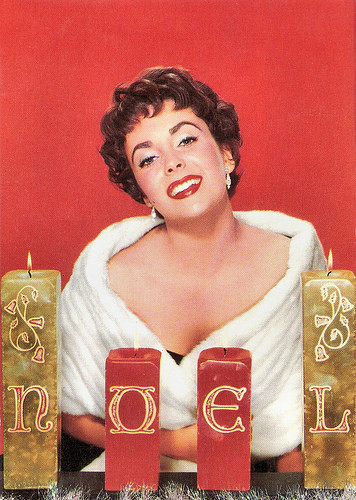
Elizabeth Taylor . French postcard by Editions P.I., Paris, no. 1051. Photo: John Everton / Ufa.
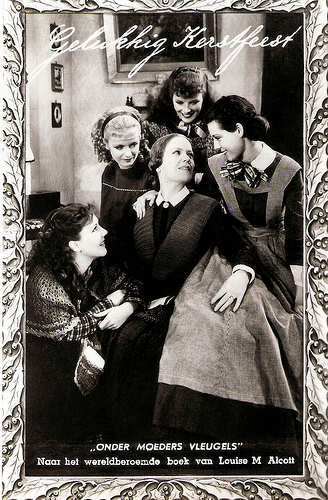
Dutch postcard by the Rialto Theatre, Amsterdam, 1934. Photo: Remaco Radio Picture. Publicity still for Little Women (George Cukor, 1933). In the picture are Katharine Hepburn, Joan Bennett, Frances Dee, Jean Parker and Spring Byington. The Dutch title of the film and the book by Louise M. Alcott is Onder moeders vleugels.
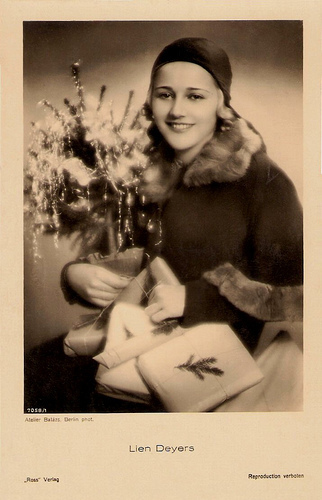
Lien Deyers . German postcard by Ross Verlag, no. 7058/1, 1932-1933. Photo: Atelier Balász, Berlin.
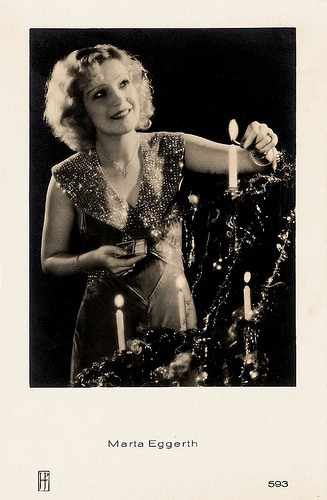
Marta Eggerth . Dutch postcard by JosPe, no. 593.
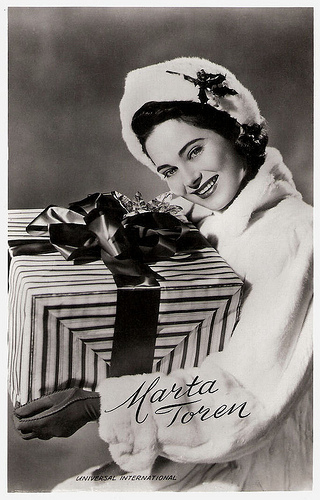
Marta Toren . Dutch postcard, no. 3374. Photo: Universal International / Fotoarchief Film en Toneel.
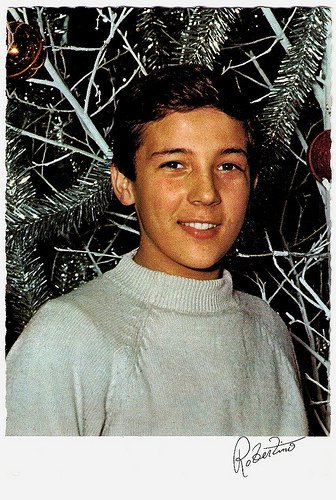
Robertino . French postcard by Editions Publistar, Marseille, no. 811. Photo: President.
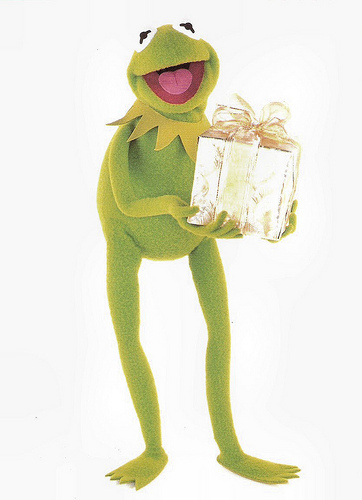
Kermit. Dutch postcard by Interstat, Amsterdam. Photo: The Jim Henson Company.
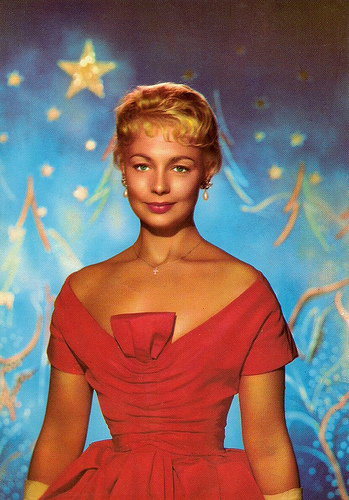
Dany Robin . French postcard by Editions P.I., Paris, no. 1004. Photo: Sam Lévin.
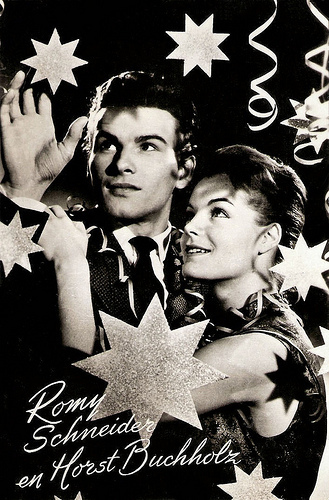
Romy Schneider & Horst Buchholz . Dutch postcard by Uitg. Takken, Utrecht, no. 3572.
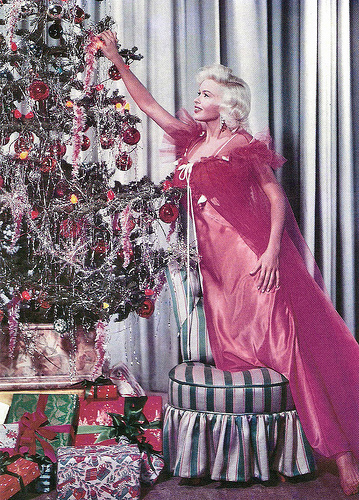
Jayne Mansfield. French postcard by Edition a la carte. Photo: Filmhistorisches Bildarchiv Peter W. Engelmeier.
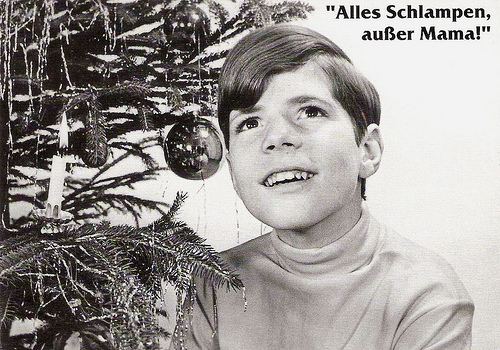
Heintje Simons . German postcard by Modern Times. Photo: Interfoto. Caption: Alles schlampen, ausser mama (All bitches, except mama).
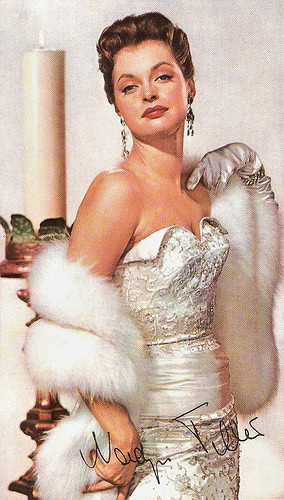
Nadja Tiller . German promotion card for Luxor.
This is a post for Postcard Friendship Friday, hosted by Beth at the The Best Hearts are Crunchy. You can visit her by clicking on the button below.


Elizabeth Taylor . French postcard by Editions P.I., Paris, no. 1051. Photo: John Everton / Ufa.

Dutch postcard by the Rialto Theatre, Amsterdam, 1934. Photo: Remaco Radio Picture. Publicity still for Little Women (George Cukor, 1933). In the picture are Katharine Hepburn, Joan Bennett, Frances Dee, Jean Parker and Spring Byington. The Dutch title of the film and the book by Louise M. Alcott is Onder moeders vleugels.

Lien Deyers . German postcard by Ross Verlag, no. 7058/1, 1932-1933. Photo: Atelier Balász, Berlin.

Marta Eggerth . Dutch postcard by JosPe, no. 593.

Marta Toren . Dutch postcard, no. 3374. Photo: Universal International / Fotoarchief Film en Toneel.

Robertino . French postcard by Editions Publistar, Marseille, no. 811. Photo: President.

Kermit. Dutch postcard by Interstat, Amsterdam. Photo: The Jim Henson Company.

Dany Robin . French postcard by Editions P.I., Paris, no. 1004. Photo: Sam Lévin.

Romy Schneider & Horst Buchholz . Dutch postcard by Uitg. Takken, Utrecht, no. 3572.

Jayne Mansfield. French postcard by Edition a la carte. Photo: Filmhistorisches Bildarchiv Peter W. Engelmeier.

Heintje Simons . German postcard by Modern Times. Photo: Interfoto. Caption: Alles schlampen, ausser mama (All bitches, except mama).

Nadja Tiller . German promotion card for Luxor.
This is a post for Postcard Friendship Friday, hosted by Beth at the The Best Hearts are Crunchy. You can visit her by clicking on the button below.

Published on December 24, 2015 22:00
Paul van Yperen's Blog
- Paul van Yperen's profile
- 13 followers
Paul van Yperen isn't a Goodreads Author
(yet),
but they
do have a blog,
so here are some recent posts imported from
their feed.



